

Dishwasher Keeps Tripping Breaker? 5 Easy Checks
Dishwasher Keeps Tripping Breaker? Dishwashers are the kind of appliance that you can ‘set and forget’. Just load them up with dishes, turn them on, and let them work.
Still, it can be very confusing and frustrating when a dishwasher keeps tripping your circuit breaker .
A dishwasher may be tripping your breaker because of a problem with the heating element, loose or short-circuiting electrical connectors, a shorted transorb, a problematic control circuit board, or even a faulty wash motor. These issues could lead to the dishwasher drawing too much current/power, causing the breaker to trip as a way of avoiding anything bad from happening.
In this article, we’re going to explore the possible reasons this problem keeps happening. By narrowing down the cause, you’ll be able to find a solution and resolve the issue much quicker.
Let’s get started.
Useful Ways To Narrow Down The Cause
Table of Contents
When troubleshooting your dishwasher to figure out why it keeps tripping the breaker, it’s essential to ask the right troubleshooting questions. Here are a few to get you started.
Is The Dishwasher Plugged Into A GFCI?
Before anything else, check to see if your dishwasher is plugged into a ground-fault circuit interrupter (GFCI).

The GFCI is also a type of circuit breaker that protects you by tripping whenever it detects an electrical current imbalance.
The difference here is that a GFCI doesn’t serve the whole house. Instead, it’s a wall socket into which you plug an appliance, such as your dishwasher.
Why This Matters
Well, suppose your dishwasher is plugged into a GFCI.
Connect with an Appliance Repair Tech
Click here to use the chatbox to speak with one of our technicians. No in-home service calls. No appointments.
If the problem lies with the dishwasher, then the GFCI will be the one tripping, not the house’s circuit breaker .
That will help you confirm that the problem is localized to the dishwasher.
However, suppose the house’s circuit breaker trips even though your dishwasher is plugged into a GFCI.
In that case, the problem may be elsewhere, and not with the dishwasher.
Does Dishwasher Keep Tripping Breaker Mid-Cycle?
To narrow down the problem to its source, it’s also crucial to figure out when the tripping actually happens.
Does it happen before, during, or after a dishwashing cycle ? Or perhaps, does it happen randomly each time, with no clear pattern?
Why This Matters
You see, each stage of the dishwashing cycle will activate different components within the machine.
So, if the breaker trips during the same stage each time, then it’ll be much easier to know which part is causing the problem.
Dishwasher Keeps Tripping Breaker? Here’s Why…
Now, we’re going to look at the dishwasher components that may be causing the circuit breaker to trip.
We’ll explore the heating element, electrical connectors, the transorb, the control board, and lastly, the motor.
Heating Element
What it is: At the bottom of a dishwasher, you’ll find a heating element.
It’s typically in the shape of a horseshoe, with one electrical connector on both ends.

As the name suggests, the only thing this component does is heat up when the time is right.
In the dishwasher, that means the heating element activates to heat up the water during the wash and rinse cycles.
Towards the end of the dishwashing process, it’ll also heat up the air as part of the drying cycle.

Why it fails: A heating element can suffer damage in many different ways. It could’ve been hit by a plate or something else inside the dishwasher.
It could also have suffered a fault causing it to develop bumps or pits somewhere along the surface of the heating element.
Whatever the case may be, a damaged heating element could end up drawing far too much power or even cause a short circuit, causing the breaker to trip.
How to fix: Heating elements aren’t really meant to be fixed. Instead, it’s much easier to replace the damaged heating element entirely.
Start by referring to your user manual or checking online to find the exact heating element compatible with your dishwasher model.
If you decide to replace it yourself, be sure to disconnect all electrical and water supplies to the unit first.
Then, refer to the user manual to locate and access the existing heating element. The tools you’ll need are minimal, such as a small wrench or screwdriver.

Electrical Connectors
What it is: Every component inside your dishwasher has electrical connectors that allow them to form a circuit together.
These connectors help the part receive power so that they can function.

However, they also connect each component to the control board, coordinating and automating their activities throughout the dishwashing cycle.
Why it fails: Electrical connectors can cause problems in a few different ways.
For example, if they weren’t properly attached in the first place, they could simply come loose after many years.
That’s especially true when the connectors are exposed to the vibrations that the dishwasher generates.
Besides that, some of the wires to those connectors could also end up exposed.
When any of these things happen, it could create a short circuit within the dishwasher.
That’ll cause the breaker to trip as a way of preventing anything terrible from happening as a result.
How to fix: The solution to this problem is to inspect all electrical connectors for issues.
Loose connections must be reapplied and tightened, while exposed wires will need to be replaced.
Typically, this job is best left to qualified professionals who have the right skills, knowledge, and experience.
However, if you decide to do it yourself, always remember to disconnect the power and water supplies to the unit before accessing the dishwasher’s insides.
Transient Voltage Suppression Diode (or ‘Transorb’)
What it is: A critical electrical component inside a dishwasher is the transient voltage suppression diode, commonly known as the ‘transorb’ or ‘TVS diode’.
This component has a straightforward function: to protect the appliance from voltage spikes that might cause damage.
Such spikes usually happen in situations like lightning strikes and more.
Why it fails: The problem here happens when the transorb gets shorted for whatever reason. A shorted transorb can cause damage to the control board while simultaneously tripping your home’s circuit breaker.
How to fix: Thankfully, the transorb is a replaceable part.
First, refer to the user manual for any information on finding a compatible transorb for your particular dishwasher model.
Remember: it’s commonly referred to by other names like ‘TVS diode’ or ‘transient voltage suppression diode’.
Once you have your transorb kit, replacing the damaged one will require access to the electrical components inside the dishwasher itself.
That’s something that’s always best left to professionals. But of course, if you decide to replace it yourself, be sure to disconnect the water and power connectors first.
Control Circuit Board
What it is: Most appliances, especially dishwashers, have a component called the control circuit board.
The simplest way to think of it is as the ‘brain’ of the entire machine.

Once you’ve told it to start the dishwashing process through the control panel , the circuit board will then power and coordinate the whole process.
The right components will activate at the correct times to ensure that your dishes are washed and dried, all under the control board’s guidance.
Why it fails: Over time, control boards can experience damage .
Parts of it could’ve burned, or perhaps it may have inadvertently been exposed to too much moisture and heat from within the machine.
A damaged control board could lead to all sorts of unusual things happening, including the tripping of your circuit breaker.
How to fix: Control boards are a very common part to replace. The key is to find the correct one for your dishwasher model in particular.
So, be sure to refer to your user manual or call the manufacturer to identify the correct model.
A skilled technician could replace it for you, but if you’re feeling adventurous, be sure to disconnect the power and water supplies before you go tinkering inside the machine.
The control board is typically located within the dishwasher door but refer to your user manual to be sure.
Faulty Motor
What it is: Dishwashers will have a motor inside which powers the pump.
Doing so will help ensure that the pump has enough power to move water to wherever it needs to be.

Clean water will spray all over the dishwasher’s insides, while dirty water is then pumped out of the dishwasher.
Why it fails: Motors are mechanical in nature, and such parts tend to fail after experiencing plenty of wear and tear.
When that happens, the dishwasher motor could be pulling far more amps than usual.
That can cause problems, especially when other components in the machine, like the heating element, for instance, also start to power on at the same time.
All of that can result in a circuit breaker tripping due to the excessive amount of power that the dishwasher is drawing as a whole.
The breaker trips as a way of preventing anything terrible from happening due to what’s going on inside the dishwasher.
How to fix: Faulty motors need to be replaced. While it’s always best to refer to a professional, you could also replace it as a DIY job.
Just be warned; replacing a dishwasher’s motor is probably one of the most challenging parts to work on.
That’s because you will probably access the motor through the bottom of the dishwasher, requiring more time and effort than replacing most other parts.
As usual, disconnect the power and water supplies before starting. Since you’re accessing the bottom of the machine, you’ll also need to drain out all of the water beforehand.
Related: Why Dishwasher Keeps Blowing Thermal Fuse
Reader Comments (35)
Good morning My dishwasher KitchenAid trip the breaker and we here a electrical noise at the machine. Not sure at what cycle but I thinks is at the cycle when the pump should start to remove the water. This happen twice at the same time and when we open the door we could feel the hot temperature that seem to be normal but the dishwasher is full of water? Do you think the problem is the pump? Thant to get back to me
From what you describe, it sounds like it could indeed be a bad pump. Perhaps it has an internal short.
However, something else to consider: Is the circuit breaker an arc-fault style breaker? Many times, these arc-fault (AFCI) breakers are oversensitive and will nuisance trip under certain appliance loads. Please see this article for more info.
My L64 Ariston dishwasher trips the circuit breaker when it’s on the heat cycle (drying ) . The dishwasher does not trip but it trips the power to power points on opposite wall ( microwave etc ) thanks
I have lived in my new home 3 1/2 years. Dishwasher has not been used every day but recently used more often as our married grandkids and family are staying here while their home is being built. For the past 6 months, the dishwasher had been tripping the breaker. The breaker has a white “Test” button and the on/off switch. It is labeled “dishwasher/disposal”. Today, the dishwasher was set to run and tripped mid-cycle (it usually trips at end, leaving water in the bottom or a few days after last used). When it happens nether dishwasher or disposal will come on until re-set, but today after re-setting the disposal started working again but the dishwasher will not come on. Does this point to a specific component that had disabled the electrical connection or is my G.E. dishwasher fried?
Our dishwasher doesn’t actually flip the circuit breaker, but just stops working after the end of a cycle. No lights on the panel. I must turn off the circuit breaker and then turn it back on. Then the dishwasher runs for several cycles and goes dead again. Any thoughts?
Hey Jim I have the same problem can you respond to this if you find an answer thanks
I also have the exact same problem. Breaker doesn’t actually flip at all but about 24 hours later no lights on dishwasher and breaker needs turned off and then on again to get it to work. Did you ever find out how to fix this?
Did you ever find a solution to this problem? I am experiencing with a GE model thanks!
I have to plug in my portable dishwasher into to GFCI wall outlet. But that GFCI outlet suddenly started tripping when I use the dishwasher. So I decided to try it using an extension cord to a distance outlet that has no GFCI and isn’t even grounded. It works fine. Any thoughts?
I don’t know when or what happened but when we went to run the dishwasher, nothing. Checked circuit breaker and it was tripped. Rest breaker and as soon as I kicked the breaker on the dishwasher made a loud click or pop. Tripped breaker again and when I reset breaker and turn back on it pops and trips circuit breaker immediately. Any ideas? Thank you.
Hi Brandon, This sounds like you have a dead short in the dishwasher or in the wiring serving the dishwasher. If you are confident in your abilities, follow these steps:
With the breaker OFF, you can look inside the small junction box under the dishwasher (typically on the right side near the front of the dishwasher, behind the skirt). Undo the wiring connections on the black and white wires. Cap off (or tape off) the circuit wires (not the dishwasher wires) so that no copper is exposed. Turn the breaker on. If the breaker now resets, the problem is either with the connection you disconnected, or in the dishwasher itself. If the breaker still won’t reset, there is a problem on the circuit. That would require more extensive testing of the house electrical system. One possibility is that the circuit wire got pinched behind the dishwasher when it was installed. Vibration over time can finally rub through the wire sheathing and insulation.
Hope that helps!
Dishwasher breaker flips when dishwasher is off. House was gutted and all new wiring and appliances. Dishwasher can be off for 18 hours and dedicated breaker will flip.
Hi Douglas, Is it on an arc-fault breaker? You can tell by looking to see if the breaker has a small test button on it (usually blue, white, yellow, or pink, depending on breaker brand). Many appliances will trip these arc-fault breakers, even though there is nothing wrong with the appliance. The code requirement for these breakers was implemented before the technology was perfected. This has caused much frustration for us electricians over the years. I would disconnect the dishwasher and see if the breaker still trips. Is so, then the problem is in the circuit. If not, then the breaker does not like something in the dishwasher. Your only code-compliant option is to get a different dishwasher (ugh!) or try a different arc-fault breaker, hoping it is not as sensitive. Many folks have resorted to changing the arc-fault breaker out with a standard breaker and have been happy ever since. But I won’t recommend that due to liability issues.
Hope this helps!
My dishwasher is on an kitchen island, I do not know if it’s plugged into a GFCI but it has a switch (like a light switch) to control the power. Sometimes the breaker flips midcycle, sometimes it flips when it’s not in use at all. On a related topic, my GFCI plugs on the same kitchen island flips as well however it’s on a separate breaker. Should I start by replacing both breakers to see if that resolves the issue?
Yeah, try to replace breaker first.
Thank you My AEG favourite has blew up the main suppressor twice! After repair it tripping RCD breaker 10min from beginning of the washing cycle and at 20min before the end of te end cycle! That’s happening from time to time Not always. Looking forward to hearing from you Michael
CFGI flicks midcycle. Home is 50 years old. Cfgi is new seems to only do it when draining. When they redid the kitchen they made it kind of impossible to pull dishwasher (2ish years old probably based on model) out. Trying to see if I have options to possibly fix it with limited access. Any thoughts?
Why do you need CFGI for the dishwasher? Do you live in California?
So the weird thing is the CFGI that’s flicking is on a separate breaker. The dishwasher is on a dedicated line and we have now gotten an electrician to come out and check breaker and CFGI to make sure wired correctly everything checks out but Dishwasher still flicks at the exact same time in the cycle. About midway through the wash near a hard drain and restart of water flow. We tested draining nothing happened it’s just that one part the flicks it.
Both the breakers for the dishwasher and microwave are tripping should I cal an electrician first?
Had my LG dishwasher for almost 2 years before it started tripping the breaker. Spent all together $200 to have it repaired. The first guy fixed it for 45 days the second guy said to change the amp on the breaker from 15 to 30! Does that even make sense?
The guy telling you to increase the amp of the breaker should not be allowed to call himself an electrician! Circuit breakers serve a purpose: to cut the power and prevent your electrical circuit from overheating and cause fire. A tripping CFGI is something entirely different. It means that current is ‘flowing away’ to ground. I don’t know the rules for the US but here in Belgium (230V) CFGI’s are mandatory for ‘wet’ environments (bathrooms, kitchens…) and should trip at 30 milli amps. The entire circuit of your home should be protected with a CFGI of 300mA. Stray current, even very low amps, might not trip the circuit breaker but can be lethal when you are in bath or taking a shower. If you have no knowledge of electricity, please don’t start fixing it yourself but call a skilled electrician. It can save your life.
My GE dishwasher randomly chirps and comes to life and occasionally has no power all when not in use?
1. Loose power connection 2. Faulty control board
For no rhyme or reason my dedicated dishwasher circuit will trip… ??
Our Bosch dishwasher trips every end of the cycle. Technician inspected and said there is no issue found on heating element, but he can’t locate the exact issue. Does it make sense to replace breaker to try?
My dishwasher will trip on its own dedicated breaker a half hour or so after it completes its cycle. It runs all the way through but will trip after cycle completion. It is on its own dedicated breaker and I can’t figure out what is happening. Any ideas?
So, what if it trips the breaker mid-cycle? I know the pump is running; I can hear the water flowing/cascading…pretty sure it’s not the heating element; it doesn’t trip at the beginning or end of the cycle. Just mid-cycle. Once the breaker gets flipped back, it runs until complete. Any help would be appropriated!!!
I think you just need to replace the breaker
What a highly useful post! Thank you so very much for helping out the DYI community. I live quite remote for service and being handy helps with excessive service costs. Servicemen are quite valuable, but simple fixes help me fix this type of smaller problem!
You are welcome
Brand new house and a brand new Whirlpool dishwasher on its own dedicated circuit in the breaker. The dishwasher just started tripping each time we attempt to run it either at the beginning, middle or end of its wash cycle. Incredibly frustrating.
I had same problem, cleaned the filter (didn’t know about it for 1st year) on the bottom and it was fixed
Thank-you for the very insightful information.
Leave a Comment Cancel reply
Save my name, email, and website in this browser for the next time I comment.
This site uses Akismet to reduce spam. Learn how your comment data is processed .

How Do I Fix a Dishwasher Tripping Breaker?

A dishwasher is a vital part of most households, simplifying the task of dishwashing and saving precious time. However, like any other appliance, dishwashers can develop issues over time. One common problem is the dishwasher tripping the circuit breaker. This issue can be frustrating and if left unaddressed, can lead to more serious problems such as electrical hazards. This comprehensive guide will walk you through the process of identifying and fixing the issue of a dishwasher tripping the breaker.
A dishwasher tripping the breaker can be caused by several issues including a faulty plug or cord, water leaks, a faulty heating element, outlet problems, damaged wires and connectors, or a faulty motor. To fix this, ensure the power supply is working, inspect the circuit breaker, check the junction box wiring, investigate potential component issues, and look for water leaks. If the problem persists, it may be best to seek professional help.
Understanding the Problem
Before we delve into the solutions, it’s important to understand why this issue occurs. Some common reasons for a dishwasher tripping the breaker include a faulty plug or cord, water leaks, a faulty heating element, outlet problems, damaged wires and connectors, and a faulty motor.
Faulty plug or cord : A damaged plug or cord can cause electrical issues, leading to the breaker tripping. Always check for any visible signs of wear and tear or damage.
Water leaks : If water leaks from the dishwasher and makes contact with electrical parts, it can cause the breaker to trip. Regularly inspect your dishwasher for any signs of water leakage.
Faulty heating element : The heating element is a crucial component of your dishwasher. If it is damaged or malfunctioning, it can draw too much electricity, causing the breaker to trip.
Outlet problem : Issues with the outlet, such as short circuits, can also cause the breaker to trip. Always ensure that the outlet is working properly.
Damaged wires and connectors : Burnt wire caps, loose cord connections, or damaged wires can lead to the breaker tripping. Regular inspection of the internal wiring of your dishwasher can prevent this issue.
Faulty motor : A damaged motor can draw more power than normal, causing the circuit board to trip.
Diagnosing the Issue
Identifying the cause of the problem is the first step in fixing your dishwasher. Here are some steps you can take to diagnose the issue:
- Check the power supply : Ensure the power cord is plugged in and the electrical outlet is functioning properly. You can test the outlet by plugging in a small lamp.
- Inspect the circuit breaker : If the breaker has tripped, reset it by flipping the switch.
- Examine the junction box wiring : Disconnect the electrical power by shutting off the house circuit breaker for the dishwasher. Remove the dishwasher’s bottom front access panel and toe panel. Check the black and white wire connections in the junction box and reconnect any loose or disconnected wires.
- Investigate potential component issues : Some common causes for a dishwasher tripping the breaker include a faulty heating element, loose or short-circuiting electrical connectors, a problematic control circuit board, or a faulty wash motor. If the breaker trips during a specific portion of the cycle, it’s likely related to a particular component.
- Look for water leaks : If your dishwasher has a leak and water is making contact with electrical parts, it can cause the circuit breaker to trip. Check for water evidence outside the dishwasher tub.
If you are unable to diagnose the issue yourself or feel uncomfortable working with electrical components, it’s best to consult a professional appliance repair technician to address the problem.
Fixing the Issue
Once you’ve identified the cause of the problem, you can proceed to fix the issue. Here are the steps you can take to address the common causes of a dishwasher tripping the breaker:
Faulty plug or cord : If the power cord is damaged, replace it. Ensure that the cord is properly plugged into the outlet.
Water leaks : If there are water leaks, repair them immediately. Leaks can cause water to come into contact with electrical parts, which can cause the breaker to trip.
Faulty heating element : If the heating element is faulty, replace it. You can test the heating element for continuity using a multimeter.
Loose or short-circuiting electrical connectors : Check the wiring connections in the junction box. Reconnect any loose or disconnected wires and reinstall the junction box cover.
Outlet problem : If the outlet is faulty, have it repaired or replaced by a professional electrician.
Faulty motor : If the motor is faulty, it will need to be replaced. This is a complex task and should be done by a professional technician.
Preventive Maintenance
Preventive maintenance can help avoid the issue of a dishwasher tripping the breaker by addressing potential problems before they escalate. Regularly inspect and clean the heating element, check for water leaks, inspect the power cord, plug, and electrical connections, and examine the dishwasher motor and other components for signs of wear or malfunction.
When to Seek Professional Help
If the problem persists despite your best efforts or if you’re not confident in your ability to safely troubleshoot and repair the dishwasher, it’s best to consult a professional technician. Signs that you may need professional help include persistent breaker tripping, visible damage to the dishwasher’s components, complex issues such as motor or control board problems, and difficulty understanding or following the troubleshooting steps.
Remember, while it’s rewarding to fix issues on your own, safety should always be your top priority. Working with electrical appliances can be dangerous, so always prioritize safety and follow the necessary precautions to avoid accidents and damage to the appliance.
By identifying the cause of the problem, following these steps to fix the issue, and performing regular preventive maintenance, you can ensure that your dishwasher operates efficiently and safely, and avoid the frustrating problem of a dishwasher tripping the breaker.
Frequently Asked Questions
What is a circuit breaker and how does it work.
A circuit breaker is a safety device designed to protect an electrical circuit from damage caused by an overload or short circuit. Its basic function is to detect a fault condition and, by interrupting continuity, immediately discontinue electrical flow.
How can I tell if the heating element of my dishwasher is faulty?
A faulty heating element may not heat up, may heat up too much, or may cause the dishwasher to trip the circuit breaker. You can use a multimeter to test the continuity of the heating element. If the multimeter shows no continuity, this means the heating element is faulty.
What should I do if I notice water leaks from my dishwasher?
If you notice water leaks from your dishwasher, first ensure that the dishwasher door is properly closed and sealed. If the leak persists, it may be due to a faulty seal, pump, or valve. It’s best to consult a professional technician to address the problem.
How often should I inspect and maintain my dishwasher to prevent issues?
It’s recommended to inspect your dishwasher for potential issues every 3 to 4 months. Regular maintenance tasks include cleaning the dishwasher filter, checking for water leaks, inspecting the power cord and outlet, and examining the dishwasher components for signs of wear or malfunction.
Can I replace a faulty motor in a dishwasher myself?
Replacing a faulty motor in a dishwasher is a complex task that involves dealing with electrical components. Unless you are experienced and comfortable with such tasks, it’s best to hire a professional technician to replace the motor to ensure safety and proper installation.
Related Posts
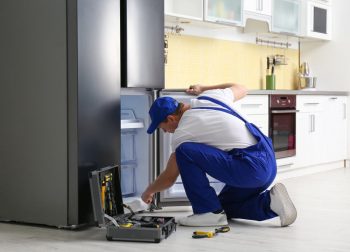
What Temperature Should Meat be Stored at in the Fridge?
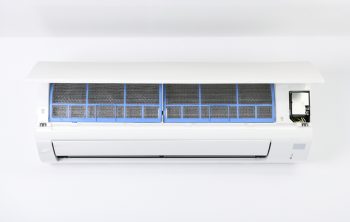
How To Get Your Air Conditioner Ready for Summer

What Is the Average Life of a Kenmore Refrigerator?

How To Run an Air Conditioner on Solar Power

Common Causes of a Noisy Water Heater

What Is the Smallest Full-Size Washer and Dryer?
About the author, trevor ritter, leave a comment cancel reply.
Your email address will not be published. Required fields are marked *
Save my name, email, and website in this browser for the next time I comment.
Trevor is an appliance repair technician with years of experience fixing all sorts of appliances. He enjoys sharing his knowledge so that others can avoid common mistakes when repairing appliances.
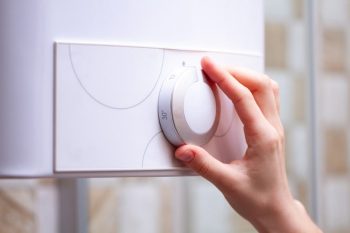
How To Make a Solar Pool Water Heater

Why Is My Oven Hissing?

How To Whiten Socks in a Washing Machine

How To Set Auto Mode in LG AC

Where Is the Charcoal Filter on a GE Microwave?

How To Disable the Child Lock on a Samsung Dishwasher
Home » Kitchen Appliances » Dishwashers
Dishwasher Keeps Tripping Breaker – Causes & Fixes
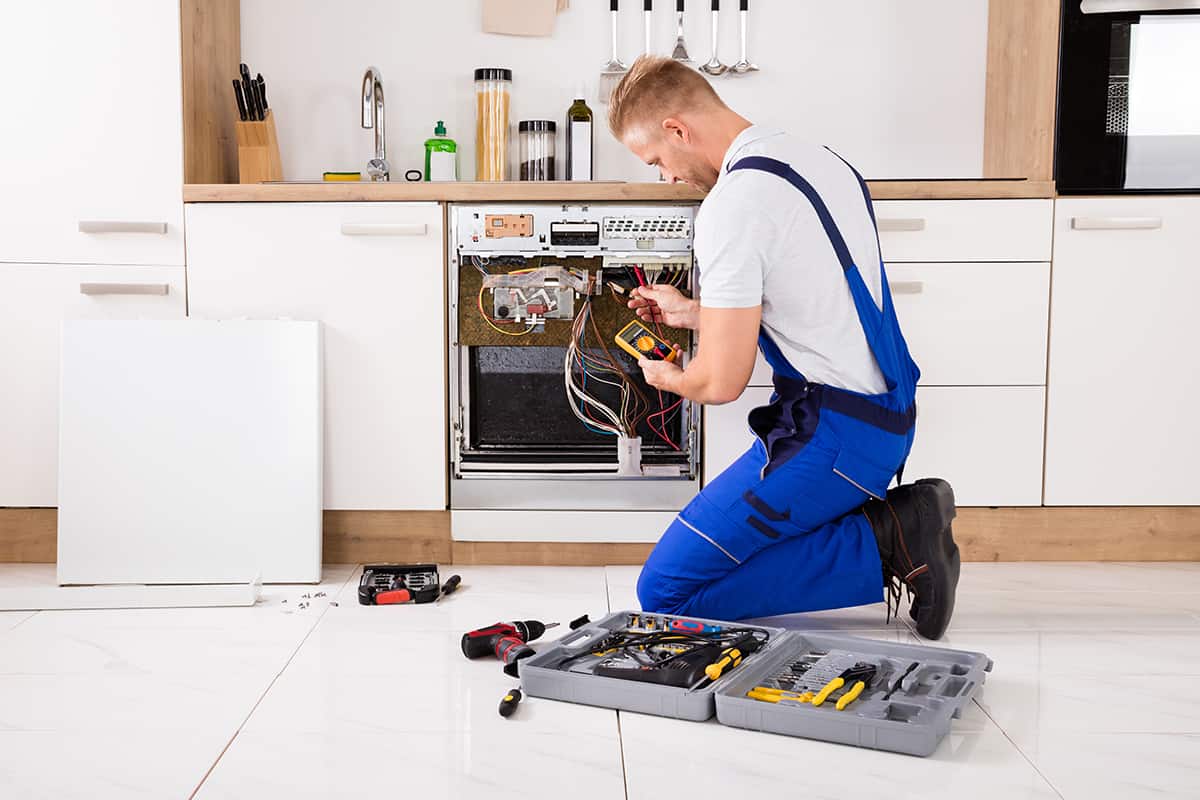
Dishwashers are an essential part of our daily lives, making it easy to clean our dishes and save time. However, sometimes dishwashers can cause problems, like tripping the breaker in your home. A tripping breaker can be frustrating and even dangerous if not handled properly.
If your dishwasher continues to trip the breaker, it could be due to any of the following causes:
- Electrical overload
- Wiring issues
- Faulty dishwasher components
- Water-related issues
- Ground Fault Circuit Interrupter (GFCI) problems
In this article, we’ll explore the common causes of a dishwasher tripping the breaker and provide you with solutions to fix these issues.
An Intro to Breakers and Dishwasher Circuits
Breakers are an important part of your home’s electrical system. Their job is to protect your home from electrical problems that can lead to problems such as fires .
They do this by stopping the flow of electricity if there’s too much going through a circuit. Dishwashers, like other appliances, have their own circuits to make sure they work well and safely.
Purpose of breakers
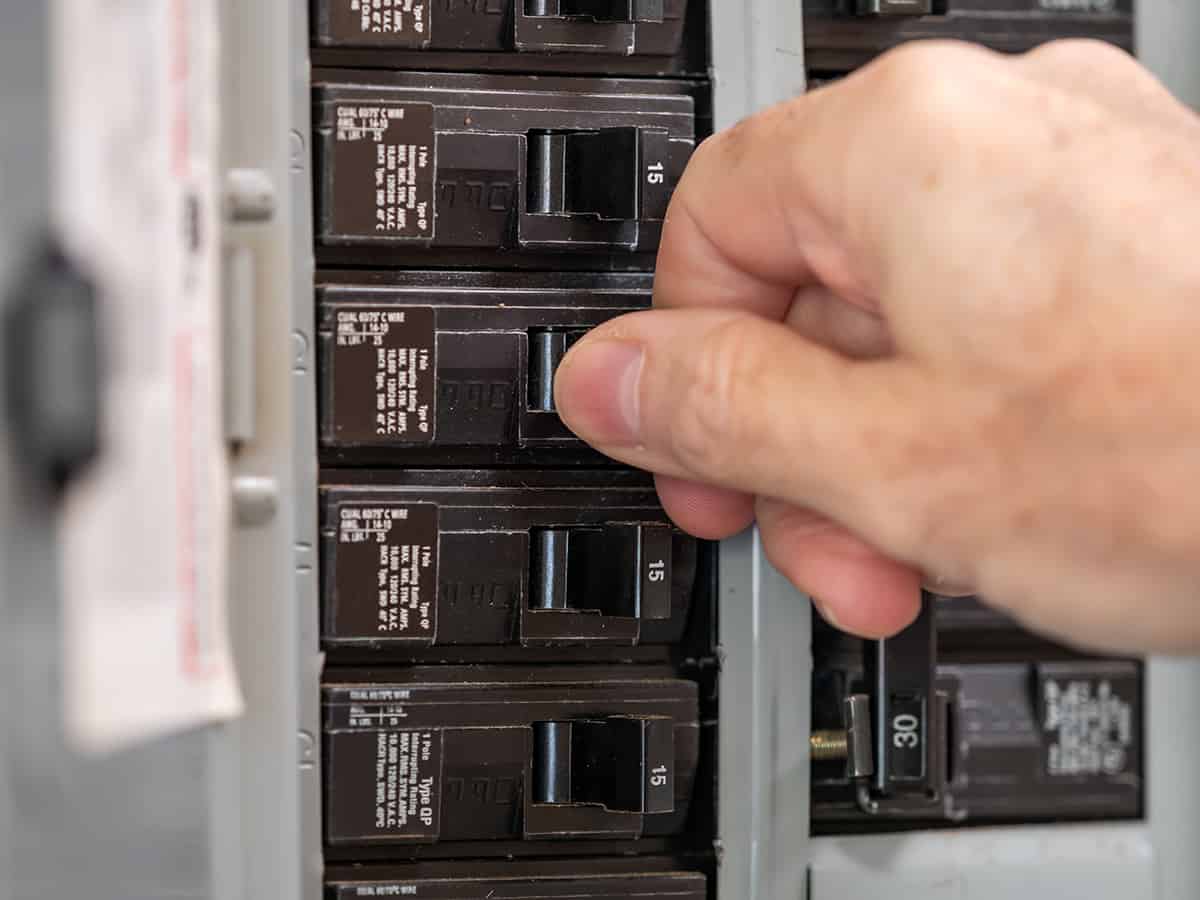
Breakers act like a safety net for your electrical system. If too much electricity flows through a circuit, the breaker will “trip” or switch off. This stops the flow of electricity, protecting your home from potential damage or fire.
Dishwasher circuit components
A dishwasher circuit is made up of several parts, including the breaker, wiring, and the dishwasher itself. These parts work together to make sure your dishwasher runs smoothly. When one part isn’t working right, it can cause the breaker to trip.
Common breaker ratings for dishwashers
Breakers are rated by how much electricity they can handle before tripping. If you’re wondering how many amps a dishwasher uses, the answer is most dishwashers need a breaker rated for 15 or 20 amps.
This rating helps make sure the dishwasher gets enough power while also keeping your home safe from electrical problems. If your dishwasher is tripping the breaker, it’s important to check if the breaker rating is correct.
Determining the Cause of Your Dishwasher Tripping the Breaker
If your dishwasher is causing the breaker to trip, it can be challenging to figure out the exact reason. However, you can follow these steps to help identify the cause and fix the issue.
- Check for recent changes —Think about any recent changes you’ve made, like adding new appliances or making adjustments to your electrical system. These changes might be related to the tripping breaker.
- Inspect the dishwasher —Look for visible signs of damage or issues, such as water leaks, burnt wires, or damaged components. These problems could be causing the breaker to trip.
- Reset the breaker and GFCI outlet —Turn off the dishwasher, reset the breaker and the GFCI outlet (if applicable), and then turn the dishwasher back on. If the breaker trips again, it’s a sign that there’s an ongoing issue.
- Test the dishwasher on a different circuit —If possible, plug the dishwasher into another circuit to see if the problem persists. If the breaker still trips, it’s likely that the issue is with the dishwasher itself.
- Consult the user manual —Check the dishwasher’s user manual for troubleshooting tips and guidance on common issues. This can help you identify the cause of the breaker tripping.
Dishwasher Keeps Tripping Breaker – Causes & Fixes
Now that we got the basics out of the way, we can focus on the more important questions—why does your dishwasher keep tripping the breaker and what can you do to fix it?
1. Electrical overload
Electrical overload occurs when there is too much electricity flowing through a circuit. This can put a strain on your home’s electrical system and cause the breaker to trip. There are a couple of common reasons for electrical overload related to your dishwasher.
- Incorrect breaker rating —Using a breaker with the wrong rating for your dishwasher can cause an overload. If the breaker is not able to handle the amount of electricity the dishwasher requires, it will trip.
- Too many appliances on one circuit —Sharing a circuit with multiple appliances can lead to an overload if they all draw power simultaneously. This can also result in the breaker tripping.
Solutions for electrical overload
- Circuit reconfiguration —Consider having an electrician reconfigure your home’s electrical circuits, ensuring your dishwasher has its own dedicated circui t. This can help prevent overloading from too many appliances sharing the same circuit.
- Upgrading the breaker —If the breaker rating is too low for your dishwasher, consult with an electrician about upgrading it to a higher rating. This will allow the dishwasher to draw the necessary power without causing an overload and tripping the breaker.
2. Wiring issues
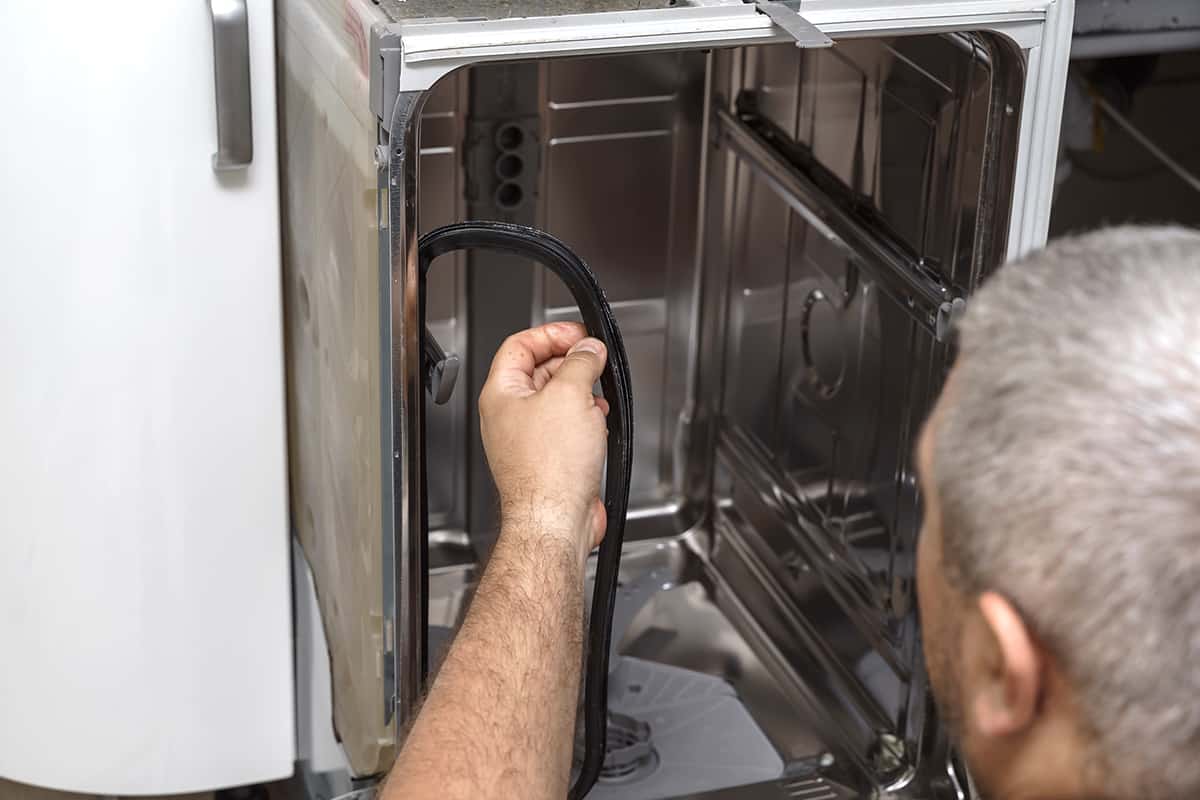
Faulty wiring can cause your dishwasher to trip the breaker. Two main types of wiring issues can lead to this problem: loose connections and damaged wires.
- Loose connections —If wires are not securely connected, they can create unstable electrical paths. This can lead to electrical issues and cause the breaker to trip.
- Damaged wires —Wires that are frayed, cracked, or corroded can also cause electrical problems. Damaged wires can create short circuits, which can trip the breaker.
Solutions for wiring issues
- Visual inspection —Turn off the power to your dishwasher and carefully inspect the wiring for any visible signs of damage or loose connections. If you find any issues, fix the connections or replace the damaged wires.
- Electrical testing —If you’re not sure about the condition of the wiring, you can use a multimeter or voltage tester to check for problems. Be cautious and consider hiring a professional electrician if you’re not confident in your ability to work with electrical systems safely. Fixing wiring issues can help prevent the breaker from tripping and keep your dishwasher running smoothly.
3. Faulty dishwasher components
Dishwashers have many parts that work together to get your dishes clean. Sometimes, these parts can break or malfunction, causing the breaker to trip. Let’s take a closer look at some of the main components that might cause this issue.
- Dishwasher motor —The motor powers the dishwasher’s spray arms and pump, helping to clean your dishes. Over time, the motor can wear out or become damaged, causing it to draw more electricity than it should. This can result in the breaker tripping.
- Heating element —The heating element is responsible for heating the water and drying the dishes. If it becomes damaged or starts to malfunction, it can cause a short circuit, leading to the breaker tripping.
- Control board —The control board is like the dishwasher’s brain , controlling all its functions. If the control board has a problem or fails completely, it can cause various issues, including the breaker tripping.
- Door latch and switches —The door latch and switches ensure that the dishwasher only operates when the door is closed securely. If these components are damaged or malfunctioning, the dishwasher may not work properly, and the breaker could trip.
Solutions for faulty dishwasher components
- If you suspect a motor issue, it’s best to have a professional examine it and determine if it needs to be replaced.
- You can check the heating element for visible damage or signs of burning. If you find any issues, it may be necessary to replace the heating element to fix the problem.
- Diagnosing control board issues can be complex and may require the help of a professional. They can determine if the control board needs repair or replacement.
- Inspect the door latch for any signs of damage, and check if the switches are functioning correctly. You may need to replace the faulty parts to resolve the issue.
4. Water-related issues

Water and electricity don’t mix well, so when water-related issues arise in your dishwasher, they can cause the breaker to trip. There are two primary concerns when it comes to water-related problems:
- Water leaks —Leaks can occur due to damaged hoses, loose connections, or cracked components in your dishwasher. When water comes into contact with electrical parts, it can create short circuits and trip the breaker.
- Flood prevention mechanisms —Some dishwashers have built-in flood prevention features that shut off the appliance if water levels get too high. These mechanisms can also trigger the breaker to trip.
Solutions for water-related issues
- Identify the source —Start by locating the source of the water leak or the cause of the flood prevention mechanism’s activation. You might need to check hoses, connections, and other dishwasher components for damage or wear.
- Repair or replace —Once you’ve identified the issue, you can tighten loose connections, replace damaged hoses, or fix any other components causing the problem. This will help prevent water from coming into contact with electrical parts and keep your dishwasher from tripping the breaker.
5. Ground Fault Circuit Interrupter (GFCI) problems
GFCI outlets monitor the flow of electricity and quickly shut off power if they detect an imbalance, reducing the risk of electrical shock. While they provide an essential safety measure, they can also be sensitive and prone to tripping.
There are two types of GFCI tripping—false tripping, which occurs when the GFCI trips without an actual electrical problem, and genuine tripping, which happens when there’s a real issue.
Solutions for GFCI problems
- Resetting the GFCI —Press the “Reset” button on the outlet to restore power. If the outlet continues to trip, there may be an underlying issue that needs further investigation.
- Replacing the GFCI —If false tripping persists, consider replacing the GFCI outlet with a new one. However, if genuine tripping occurs, you should investigate the root cause, as it may indicate a more serious problem with your dishwasher or electrical system. In this case, consulting a professional electrician is recommended.
You May Also Like

Leave a Reply Cancel reply
Your email address will not be published. Required fields are marked *
Save my name, email, and website in this browser for the next time I comment.
Common Causes of Dishwasher Electrical Overloads
In this section, we will explore the various factors that can lead to your dishwasher causing repeated tripping of the circuit breaker. It is important to understand these common causes in order to effectively troubleshoot and resolve the issue.
- Electrical Surges: Unstable power supply or electrical surges can put excessive strain on the dishwasher, leading to circuit breaker trips.
- Faulty Wiring: Poorly connected or damaged wiring within the dishwasher or the electrical system can result in electrical overloads.
- Excessive Load: Overloading the dishwasher with an excessive amount of dishes or utensils can cause it to draw more power than the circuit breaker can handle.
- Defective Components: Faulty components like heating elements or motors can cause electrical issues that result in circuit breaker tripping.
- Water Damage: Water leaking into the electrical components of the dishwasher can cause short circuits and trigger the circuit breaker.
By identifying the specific cause behind the repeated tripping of your dishwasher’s circuit breaker, you will be able to take appropriate steps to fix the problem and prevent future electrical overloads.
Understanding the Issue
When dealing with a persistent electrical problem in your dishwasher, it’s essential to gain a comprehensive understanding of the issue at hand. By familiarizing yourself with the underlying causes, you can effectively troubleshoot and resolve the problem without the need for professional assistance.
The recurring circuit breaker trips on your dishwasher indicate an electrical fault that disrupts the normal operation of the appliance. This malfunction can stem from various factors, such as overloaded circuits, faulty components, or wiring issues.
To pinpoint the specific cause of the circuit breaker tripping, you’ll need to carry out a thorough inspection of your dishwasher’s electrical system. This inspection includes checking for any loose or damaged electrical connections, evaluating the condition of the dishwasher’s internal wiring, and examining the functioning of critical components like the heating element or motor.
Understanding the root cause of the circuit breaker trips will enable you to make informed decisions when it comes to troubleshooting and resolving the issue. By systematically identifying and addressing the underlying problem, you can restore your dishwasher to its optimal functioning and avoid future electrical disruptions. The following section will guide you through the step-by-step process of identifying and resolving the problem to effectively fix your dishwasher’s circuit breaker tripping issue.
Identifying the Issue
When your dishwasher keeps repeatedly tripping the circuit breaker, it is important to identify the underlying problem in order to find a solution. The issue could stem from various factors, and understanding the potential causes can help in troubleshooting and resolving the problem effectively.
One possible reason for the circuit breaker tripping could be an electrical overload. This occurs when the dishwasher draws more power than the circuit can handle, leading to a surge that triggers the breaker. Another possibility is a faulty or short-circuited component within the dishwasher itself, such as a damaged heating element or a malfunctioning motor.
Additionally, issues with the electrical wiring or connections can also cause the circuit breaker to trip. Loose or damaged wires, as well as incorrect wiring configurations, can create an unstable electrical flow and result in the breaker being triggered as a safety measure.
To accurately identify the issue, you can start by visually inspecting the dishwasher for any obvious signs of damage or wear. Check the electrical connections to ensure they are securely fastened and examine the wiring for any frayed or exposed areas. It may also be helpful to consult the dishwasher’s manual or look for troubleshooting resources specific to your model.
If the problem persists after initial inspections, it is recommended to seek professional assistance. A licensed electrician or appliance repair technician will have the necessary expertise to diagnose and fix the issue safely.
- Check for electrical overload
- Inspect dishwasher components for faults
- Examine electrical wiring and connections
- Consult the dishwasher’s manual or troubleshooting resources
- Seek professional assistance if necessary
Common Causes
The dishwasher’s repeated activation of the circuit breaker can be attributed to various underlying factors. Identifying these common causes can help in troubleshooting and resolving the issue.
1. Electrical Overload: Excessive power consumption by the dishwasher may overwhelm the circuit breaker, leading to frequent tripping. This can be caused by various factors such as a malfunctioning heating element or a faulty motor.
2. Water Leakage: When water seeps into the electrical components of the dishwasher, it can result in a short circuit and cause the circuit breaker to trip. Leaks can occur due to loose connections, damaged seals, or clogged drain pipes.
3. Faulty Wiring: Improper wiring connections or damaged wires can cause an irregular flow of electricity, leading to circuit breaker trips. This can occur due to improper installation, wear and tear, or rodent damage.
4. Defective Components: Malfunctioning parts within the dishwasher, such as the control board, timer, or door switch, can result in the dishwasher exceeding the electrical capacity, causing the circuit breaker to trip.
5. Circuit Breaker Issues: In rare cases, the problem may lie with the circuit breaker itself. A weak or faulty breaker may trip even with normal dishwasher operation. Consulting a professional electrician can help determine if this is the cause.
Identifying the specific cause of the repeated circuit breaker trips is crucial in effectively troubleshooting and resolving the issue with your dishwasher. By addressing these common causes, you can ensure proper functioning of your appliance and prevent future disruptions.
Importance of Fixing
Addressing the issue with your dishwasher is crucial for various reasons. By resolving the persistent problem that causes your dishwasher to trip the circuit breaker, you can restore the efficient functioning of the appliance, ensuring its longevity and avoiding potential hazards.
Fixing the issue not only saves you from the inconvenience of constantly resetting the circuit breaker, but it also prevents further damage to your dishwasher’s electrical components. Neglecting the recurring problem can lead to more severe issues, such as burnt-out motors or damaged wiring, which can be costly to repair or replace.
Moreover, resolving the tripping issue demonstrates your commitment to maintaining a safe and reliable home environment. Continual tripping of the circuit breaker is often a sign of an underlying electrical problem, which can pose a threat of fire or electrical shock. By troubleshooting and fixing the dishwasher’s tripping issue, you proactively eliminate potential hazards and ensure the safety of your household.
In addition, a properly functioning dishwasher enhances your daily routine by providing the convenience and efficiency it was designed for. With a reliable appliance, you can save time, effort, and resources, allowing you to focus on other tasks or enjoy quality time with your loved ones. Fixing the dishwasher not only eliminates the inconvenience of a faulty appliance but also improves your overall experience in the kitchen.
Finally, addressing the tripping issue demonstrates your commitment to sustainable living. A malfunctioning dishwasher that frequently trips the circuit breaker consumes more energy, leading to unnecessary wastage. By fixing the issue, you ensure that your dishwasher operates efficiently, reducing your energy consumption and contributing to a greener and more environmentally friendly lifestyle.
Checking for Electrical Overload
One common issue that can cause a dishwasher to repeatedly trip the circuit breaker is electrical overload. In simple terms, this happens when the dishwasher draws too much power from the circuit, exceeding its capacity and causing the breaker to trip as a safety mechanism. If you suspect electrical overload is the problem, there are several steps you can take to check for it.
- Inspect the power cord: Begin by examining the dishwasher’s power cord for any visible signs of damage, such as frayed or exposed wires. A damaged power cord can lead to electrical problems and may be the cause of the circuit breaker tripping. If you notice any issues with the power cord, it should be replaced.
- Check the outlet: Ensure that the outlet used for the dishwasher is properly grounded and meets the necessary electrical requirements. A faulty or insufficiently grounded outlet can result in excessive power draw and cause the circuit breaker to trip. Consider testing the outlet with a voltage tester to verify its functionality.
- Review the circuit breaker: Examine the circuit breaker connected to the dishwasher’s power supply. Look for any signs of damage or corrosion, as these can contribute to electrical issues. Additionally, check if the circuit breaker is appropriately sized for the dishwasher’s power requirements. If it’s undersized, it may be unable to sustain the dishwasher’s power demands, causing it to trip frequently.
- Check for other appliances on the same circuit: Determine if there are any other heavy electrical appliances connected to the same circuit as the dishwasher. Sharing a circuit with high-power devices like refrigerators or microwaves can overload the circuit and result in breaker trips. Consider redistributing the load by plugging the dishwasher into a different electrical circuit.
- Consider hiring a professional: If you’ve followed the above steps and are still experiencing circuit breaker trips, it may be necessary to consult a professional electrician. They can inspect the wiring, circuit breaker panel, and overall electrical system to identify any underlying issues or recommend a solution.
By thoroughly checking for electrical overload and addressing any potential problems, you can increase the chances of resolving the issue with your dishwasher tripping the circuit breaker. Remember, safety should always be a priority when dealing with electrical systems, so if you’re unsure or uncomfortable with any of the steps mentioned, it’s best to seek professional assistance.
Resetting the Circuit Breaker
If your dishwasher keeps causing the electrical breaker to trip, you might need to reset the circuit breaker. This is a common issue that many homeowners encounter with their appliances, and it can be frustrating when it happens repeatedly. However, by following some simple steps, you can easily reset the circuit breaker and get your dishwasher back up and running.
Firstly, locate the electrical panel in your home. This panel is usually found in the basement or utility room, and it contains all the circuit breakers for your house. Look for the breaker that corresponds to your dishwasher. Typically, it will be labeled with the room or area it serves, such as “kitchen” or “dishwasher.”
Once you’ve identified the correct breaker, you can proceed with resetting it. To do this, firmly push the breaker switch to the “off” position and then back to the “on” position. This action will reset the circuit breaker and restore power to your dishwasher. It’s important to make sure the switch is fully pushed to the “off” position before turning it back on.
After resetting the circuit breaker, give it a few moments to stabilize. Sometimes, a temporary surge in power can cause the breaker to trip, so allowing it a brief period of rest can help prevent any further issues. Once you’ve waited for a few minutes, you can test your dishwasher by running a quick cycle to see if the circuit breaker remains stable.
If the circuit breaker trips again after resetting, there might be an underlying issue with your dishwasher that requires professional attention. It could indicate a more serious electrical problem or a malfunctioning component within the dishwasher itself. In such cases, it’s best to contact a qualified professional to diagnose and fix the issue.
In summary, resetting the circuit breaker is an essential step in troubleshooting a dishwasher that keeps tripping the breaker. By following the proper procedure and allowing for a brief rest period, you can often resolve the issue and restore power to your dishwasher. However, if the problem persists, it’s advisable to seek professional help to identify and resolve any underlying problems.
Unplugging Other Appliances
When encountering a situation where your dishwasher is repeatedly tripping the circuit breaker, it can be helpful to assess the usage of other electrical appliances in your home. Disconnecting or unplugging other appliances that are on the same circuit as your dishwasher is a recommended troubleshooting step. By reducing the overall electrical load on the circuit, you may be able to determine if the problem lies with the dishwasher itself or if there is an issue with the circuit or other connected appliances.
Identifying Potential Culprits
Electrical appliances such as microwaves, refrigerators, and washing machines can share the same circuit as your dishwasher. If any of these appliances are simultaneously running while you experience the tripping issue with your dishwasher, it may be worth unplugging them temporarily as part of the troubleshooting process. It is important to note that older homes or apartments with limited electrical circuits are more prone to overload, making the unplugging of other appliances even more crucial in identifying the root cause of the problem.
Isolating the Dishwasher
Before proceeding with unplugging other appliances, it is advisable to turn off the power supply to the entire circuit to avoid any potential electrical shock. Once the circuit has been safely turned off, you can disconnect the other appliances one by one and test the dishwasher to see if it continues to trip the circuit breaker. This step-by-step approach helps in isolating the dishwasher and identifying whether it is the main culprit behind the tripping issue.
Seeking Professional Help
If unplugging other appliances does not resolve the problem or if you are not comfortable with performing these steps on your own, it is recommended to seek the assistance of a licensed electrician. They have the expertise and knowledge to diagnose and fix complex electrical issues, ensuring the safety and proper functioning of your dishwasher and other appliances.
Remember, troubleshooting electrical problems can be a hazardous task, and it is important to prioritize your safety. Always exercise caution and seek professional help when needed.
Inspecting the Dishwasher
When troubleshooting issues with your dishwasher, one important step is to thoroughly inspect its various components. By carefully examining the dishwasher, you can identify potential sources of the problem and take appropriate actions to fix it.
Start by visually inspecting the exterior of the dishwasher, checking for any visible signs of damage or wear. Look for cracks, dents, or loose connections that could potentially lead to electrical issues.
Next, carefully open the dishwasher door and inspect the interior. Pay close attention to the inner walls, door seals, and any rubber gaskets for signs of leaks or wear. Also, check the racks and utensil holders for any bent or broken parts that could interfere with the proper functioning of the dishwasher.
Inspect the control panel and buttons, making sure they are in good condition and working properly. Look for any loose wires or signs of electrical damage that could be causing the circuit breaker to trip.
If your dishwasher has a filter, remove it and inspect it for any clogs or debris. A clogged filter can impede the dishwasher’s performance and cause electrical issues.
Lastly, take a moment to inspect the dishwasher’s power cord and plug. Look for any frayed wires or loose connections that could be causing the circuit breaker to trip.
In summary, a thorough inspection of the dishwasher’s exterior, interior, control panel, filter, power cord, and plug can help you identify any visible issues that may be causing it to trip the circuit breaker. By addressing these potential problem areas, you can effectively troubleshoot and resolve the issue.
Verifying Proper Installation
Ensuring that your dishwasher is installed correctly is crucial for its proper functioning and to avoid recurring circuit breaker trips. In this section, we will discuss the importance of verifying the installation of your dishwasher without specifically referring to the troubleshooting process.
1. Optimal Electrical Connection: Begin by confirming that the electrical connection of your dishwasher meets the necessary requirements. Check the power cord and make sure it is securely plugged into a grounded outlet. Verify that the cord is not frayed or damaged, as this could result in a short circuit and cause frequent circuit breaker trips.
2. Adequate Wiring: Ensure that the wiring within your dishwasher is correctly installed and insulated. Examine the internal wiring for any signs of damage, such as exposed or loose wires. Proper insulation ensures that the electrical components of your dishwasher are protected and prevents any potential electrical hazards.
3. Proper Grounding: Verify that your dishwasher has been effectively grounded. Grounding is essential for the safety of the appliance and helps to prevent electrical shocks. Check that the grounding wire is securely connected to the appropriate terminal or grounding screw in accordance with the manufacturer’s guidelines.
4. Water Connections: In addition to electrical connections, it is crucial to inspect the water connections of your dishwasher. Ensure that the water supply hose is properly attached and free from any leaks. A faulty water connection can cause electrical malfunctions, increasing the risk of circuit breaker trips and potentially damaging your dishwasher.
By verifying the proper installation of your dishwasher, you can eliminate potential issues that may lead to circuit breaker trips. Following the guidelines outlined in this section will help ensure a safe and efficient operation of your dishwasher.
Checking for Loose Connections
In this section, we will explore the importance of inspecting your dishwasher for any loose connections that could be causing it to trip the circuit breaker. Ensuring that all electrical connections are secure is crucial for the proper functioning of your dishwasher.
Loose connections can occur due to various factors, such as vibrations during the dishwasher’s operation or improper installation. These connections can disrupt the flow of electricity, leading to a tripped circuit breaker. Therefore, it is essential to inspect all the connections and take the necessary steps to fix any loose ones.
To begin checking for loose connections, start by turning off the dishwasher and unplugging it from the power source. This step is crucial to ensure your safety throughout the inspection process.
1. Inspect the power cord: Examine the power cord for any signs of wear or damage, such as frayed wires or exposed insulation. If you notice any issues, it is vital to replace the power cord to prevent further electrical problems.
2. Examine the outlet: Inspect the outlet where your dishwasher is plugged in. Ensure that the outlet is securely connected to the wall and that there are no loose wires or visible damage. If you detect any problems, consider calling a qualified electrician to repair or replace the outlet.
3. Check the dishwasher’s electrical connections: Carefully examine all electrical connections within the dishwasher, such as wire nuts and terminal blocks. Ensure that they are tightly secured and that there are no loose or corroded wires. If you find any loose connections, use a screwdriver or a pair of pliers to tighten them properly.
4. Verify the door latch: In some cases, a loose door latch can also cause the dishwasher to trip the circuit breaker. Ensure that the door latch is securely fastened and that it engages properly when the dishwasher is closed. Adjust or replace the latch if necessary.
5. Seek professional assistance: If you have followed these steps and are still experiencing issues with your dishwasher tripping the circuit breaker, it is recommended to seek assistance from a qualified appliance repair technician. They will have the expertise to diagnose and fix any underlying electrical problems with your dishwasher.
By checking for loose connections and ensuring their proper tightening and functionality, you can reduce the chances of your dishwasher tripping the circuit breaker and maintain its optimal performance.
Addressing Water Leaks
You may encounter a situation where your dishwasher is causing water leaks. This issue can disrupt the functioning of your dishwasher and potentially lead to further damage if not addressed promptly. In this section, we will explore common causes of water leaks and provide steps to help you resolve the problem.
Potential Causes:
There are several factors that can contribute to water leaks in your dishwasher. Identifying the underlying cause is crucial to effectively addressing the issue. Here are some potential causes to consider:
1. Faulty Door Seal: The door seal, often made of rubber or silicone, ensures a tight closure when the dishwasher is in use. Over time, this seal can become worn out or damaged, allowing water to escape. Inspect the door seal for any signs of tears or gaps.
2. Clogged Drainage System: A clogged drainage system can cause water to back up and overflow from your dishwasher. Check the drainage hose, air gap, and garbage disposal connection for any obstructions.
3. Loose or Damaged Hose Connections: The hoses responsible for supplying and draining water may develop loose connections or get damaged. This can result in water leakage. Examine the hoses and tighten any loose connections. Replace damaged hoses if necessary.
4. Improper Dishwasher Leveling: If your dishwasher is not properly leveled, it may tilt or lean to one side, causing water to spill out. Use a level tool to ensure that your dishwasher is level and adjust the feet as needed.
Steps to Resolve the Issue:
Now that you have identified potential causes, follow these steps to address water leaks in your dishwasher:
1. Inspect the door seal for any visible damage. If you notice any tears or gaps, replace the seal according to the manufacturer’s instructions.
2. Check the drainage system for any clogs. Clear out any obstructions in the drainage hose, air gap, or garbage disposal connection.
3. Ensure that all hose connections are secure and tightened properly. Replace any damaged hoses.
4. Use a level tool to check if your dishwasher is properly leveled. Adjust the feet to level the dishwasher if necessary.
5. After making these adjustments, run a test cycle to check for any remaining leaks. Monitor your dishwasher closely to ensure that the issue has been resolved.
By addressing water leaks in your dishwasher, you can prevent further damage and ensure its smooth functioning. Taking these steps will help you address the issue effectively and save you from the inconvenience of a malfunctioning dishwasher.
Examining the Door Gasket
When troubleshooting dishwasher issues, it’s important to pay attention to all components, and that includes the door gasket. The door gasket is a crucial part of the dishwasher, as it forms a seal between the door and the dishwasher cavity, preventing water leakage during the wash cycle. However, over time, the door gasket can wear out or become damaged, leading to potential problems.
One common issue that can arise from a faulty door gasket is that the dishwasher may trip the circuit breaker. This occurs when water leaks out from the door due to a compromised seal, causing an electrical short circuit. In such cases, it is crucial to examine the door gasket closely and ensure its proper functioning.
Start by visually inspecting the door gasket for any visible signs of wear or damage. Look for cracks, tears, or deformities that could compromise its ability to create an effective seal. Additionally, check for any foreign objects, such as food debris or grime, that may be lodged in the gasket and preventing it from properly sealing.
Next, gently run your fingers along the entire length of the gasket to feel for any inconsistencies or irregularities. Pay attention to areas that feel softer or harder than the rest, as this could indicate a damaged or deteriorating gasket. If you notice any issues during this inspection, it is recommended to replace the door gasket to ensure proper functioning of the dishwasher and avoid further circuit breaker tripping.
Remember: Regular maintenance and cleaning of the door gasket are essential to prevent premature wear and tear. Use a mild detergent and a soft cloth to clean the gasket, ensuring that no residue or debris is left behind. Additionally, avoid slamming the dishwasher door shut, as this can put unnecessary strain on the gasket and lead to its deterioration over time.
Proper examination and maintenance of the door gasket can help resolve circuit breaker tripping issues and ensure the smooth operation of your dishwasher. By addressing any problems with the gasket promptly, you can enjoy clean dishes without the inconvenience of a malfunctioning appliance.
Inspecting the Drain Hose
One crucial aspect of troubleshooting a dishwasher that keeps tripping the circuit breaker involves inspecting the drain hose. This component plays a vital role in the proper functioning of the dishwasher’s drainage system.
To begin inspecting the drain hose, first, ensure that the dishwasher is disconnected from its power source. Safety is paramount when working with electrical appliances.
Next, carefully locate the drain hose, which is typically located at the back of the dishwasher. It is often connected to the sink’s drainage system or looped up to the underside of the countertop. Take note of any kinks, cracks, or visible damages to the hose.
Using a flashlight, inspect the inside of the drain hose for any blockages or debris. Clearing any clogs or obstructions will allow proper water flow and prevent the circuit breaker from tripping.
Check the hose connections at both ends, ensuring they are securely fastened. Loose connections may lead to water leakage, which can cause electrical issues and circuit breaker tripping.
If any issues are detected with the drain hose, it may need to be replaced. In this case, consult the dishwasher’s instruction manual or contact a professional for further assistance.
Dealing with a Faulty Heating Element
In this section, we will explore the steps to address a malfunctioning heating element in your dishwasher. The heating element plays a crucial role in ensuring optimal temperature levels for efficient dishwashing. A malfunctioning heating element can lead to inadequate heating, resulting in improper cleaning and drying of dishes.
Identifying the Issue: When faced with a dishwasher that constantly trips the circuit breaker, a potential cause could be a faulty heating element. Signs of a malfunctioning heating element include cold water during the wash cycle, dishes not drying properly, or an unusual burning smell.
Visual Inspection: Start by turning off the dishwasher and unplugging it from the power source. Carefully inspect the heating element for any visible signs of damage, such as cracks, breaks, or discoloration. If you notice any damages, it is likely that the heating element needs to be replaced.
Testing the Heating Element: To further confirm whether the heating element is faulty, you can use a multimeter. Set the multimeter to the resistance setting and touch the probes to the terminals of the heating element. If the multimeter displays a reading of infinity or a significantly higher resistance value than the manufacturer’s specification, it indicates a faulty heating element.
Replacing the Heating Element: If the heating element is indeed faulty, it is necessary to replace it. Consult your dishwasher’s owner manual or contact the manufacturer to obtain a compatible replacement part. Additionally, it is advisable to seek professional assistance if you do not possess the necessary skills or experience to replace the heating element yourself.
Note: Always remember to disconnect the dishwasher from the power source before attempting any repairs or replacements to ensure your safety.
Conclusion: A faulty heating element can cause various issues in your dishwasher, disrupting its overall performance. By properly identifying and addressing this issue, you can restore the efficiency and effectiveness of your dishwasher’s cleaning and drying functions.
Testing the Heating Element for Continuity
In order to troubleshoot and fix a dishwasher that repeatedly causes the circuit breaker to trip, it is important to check the heating element for continuity. The heating element is an essential component responsible for heating the water during the wash and rinse cycles. If the heating element is faulty or damaged, it can lead to excessive electrical current, causing the circuit breaker to trip.
To test the heating element for continuity, follow these steps:
By testing the heating element for continuity, you can determine whether it is the culprit behind the repeated circuit breaker tripping. Remember to always prioritize safety and disconnect the dishwasher from the power source before performing any troubleshooting or repair tasks.
Replacing the Heating Element
When dealing with a dishwasher that continually causes a disruption in the electrical system, one potential culprit to consider is the heating element. In this section, we will explore the process of replacing this essential component.
To begin, it is crucial to identify the signs that indicate a faulty heating element. These indicators may include a lack of hot water during the dishwasher cycle, dishes that are not drying properly, or a tripped circuit breaker. In case you encounter one or more of these issues, it is time to examine and potentially replace the heating element.
Before starting the replacement process, it is vital to ensure the dishwasher is completely disconnected from the power source. This can be done by unplugging the dishwasher or turning off the circuit breaker that supplies electricity to it. Safety should always be a priority when working with electrical components.
Next, locate the heating element within the dishwasher. It is typically found at the bottom of the tub, underneath the lower rack. Once located, carefully remove any surrounding components that may obstruct access to the element, such as the spray arm or the filter.
With the heating element exposed, inspect its condition for any visible damage, such as cracks, corrosion, or burn marks. If any of these issues are present, it is likely that the heating element is the root cause of the circuit breaker tripping. In such cases, it is necessary to procure a replacement heating element.
Prior to installing the new heating element, be sure to consult the manufacturer’s instructions or refer to the dishwasher’s manual for specific guidelines regarding your model. Following these instructions will ensure a successful replacement and minimize the risk of further issues.
Carefully attach the new heating element, ensuring proper alignment and connection to the dishwasher’s electrical system. Reassemble any previously removed components, double-checking that everything is securely in place.
Once the heating element and associated components are installed, it is time to restore power to the dishwasher. Plug it back in or turn the circuit breaker back on, and test the appliance to ensure that it no longer trips the circuit breaker. In the event that the tripping issue persists, it may be wise to seek professional assistance or consult a licensed electrician.
In conclusion, replacing the heating element can be a practical solution if your dishwasher repeatedly trips the circuit breaker. By following the necessary precautions and carefully carrying out the replacement process, you can restore your dishwasher’s functionality and eliminate the electrical disruption.
The Enigma of a Dishwasher Tripping the Circuit Breaker: Why and How to Fix It?
Ahoy there, fellow DIY-ers! Gather around as we embark on a journey to solve the mystery of your dishwasher. You’ve probably been wondering, “Why does my dishwasher keep tripping the circuit breaker?” Well my friends, as your resident go-to repairman, I'm here to shed some light on this electrical enigma.
The Dishwasher Dilemma
Life is sweet with a dishwasher, isn't it? You load it up, turn it on, and voilà your dishes are as good as new. But when you start tripping the circuit breaker regularly, it's a definite cry for help. Your dishwasher is sending you an SOS, like a code in a spy movie; it's high time you decipher it and save the day.
Why should you bother? Well, if your dishwasher keeps tripping the breaker, it's not just an inconvenience; it’s a potential electrical fire hazard. And hey, we'd rather spend our time cooking up a sizzling steak on the grill than a short circuit on our fuse box, wouldn't we?
Understanding the Invisible Foe – Electrical Overload
But before we dive into the how-tos, let’s break down the basics. Why does a dishwasher trip the circuit breaker? The culprit is often an electrical overload. Circuit breakers are designed to protect your home’s electrical system. When there's too much demand on a circuit, the breaker "trips" or shuts off, effectively preventing any Grim Reaper-style fire outbreaks.
1. Dishwasher Gone Rogue
Now here's the hat-trick question: Where's the overload coming from? Well, the first suspect is always the scene of the crime - your dishwasher. A rogue element such as a damaged heating element, faulty motor, or shorted wiring could be making your dishwasher draw more power than it should, causing the frequent tripping.
2. Double Trouble Circuits
If your dishwasher seems innocent, the real traitor could be the circuit it’s on. Dedicating single circuits to single large appliances is usually the norm. Double booking with other energy hogging appliances can overload the circuit. My advice? Check what else is on the same circuit, and consider redistributing your electrical load.
Detective Work – Identifying the Culprit
Now let’s roll up our sleeves and play detective. Troubleshooting can reveal if it's your dishwasher Gone Rogue or the Double Trouble circuit.
Firstly, unplug the dishwasher from the circuit. Try plugging in a different appliance and see if it causes the circuit to trip. If it does, your suspect is the circuit, not the dishwasher. If the circuit remains stable, there’s something fishy with your dishwasher.
The Repairman's Toolkit – Fixing the Problem
Identified the criminal? Fantastic! Now, let’s work on setting things right.
Fixing a Rogue Dishwasher
If your dishwasher is to blame, I'd suggest giving it a thorough inspection. Keep an eye out for any loose wires, or elements that look damaged or worn out. Unless you're pretty handy with electrical DIY, it might be best to call in a professional for the job. Dishwasher repairs can be pretty complicated and are best left to experienced tech-tinkering hands.
Resolving Circuit Issues
Now if your circuit is at fault, consider any high-power appliances on the same circuit and try isolating them onto different circuits. If things still seem overloaded, it might be worth getting a professional electrician to take a look. They can upsize the circuit breaker or your panel capacity if needed, to handle higher loads.
The Dishwasher Rescue Plan
So dear friends, the next time your dishwasher plays the breaker tripping prank, you're now armed with the DIY knowledge to solve it. Remember, always prioritize safety over DIY spirit when dealing with electricity. If in doubt, call in the professionals.
We’ve unraveled the mystery, provided the toolkit, and empowered you to solve it. And always remember, even when the dishwasher seems too much to handle, there's no need to pull your hair out over it. In the grand scheme of life, it's just dirty dishes, after all.
Here's to keeping our dishwashers humming happily and our circuit breakers peacefully at rest. Happy DIY-ing folks!
Browser Security Check…

Why Dishwasher Keeps Tripping Breaker? [SOLVED] – Let’s Fix It
If your dishwasher keeps tripping breaker and you feel like the only solution is to replace it, there may be a few things you can check first to try and fix it. Depending on what kind of dishwasher you have, the model and manufacturer, there could be a few different issues causing your circuit breaker to trip.
When a dishwasher keeps tripping your home’s circuit breaker, the problem is often not with the dishwasher itself. It’s likely that it’s the electrical wiring or other appliances (like the fridge or oven) connected to the same circuit. That means that whatever you do, the breaker on that particular circuit will keep tripping.
If you’re experiencing problems with your dishwasher, there are a few possible reasons why it keeps tripping the breaker. Determining which issue is affecting your dishwasher will help you find a solution much more quickly than simply replacing parts or performing unnecessary troubleshooting.
Why Dishwasher Keeps Tripping Breaker – Troubleshooting and Diagnosis
You might have a problem with your dishwasher, specifically concerning its heating element or electrical connectors. This could be the reason why it’s tripping the breaker. If you inspect the appliance and find no problem, it may be time to call in an electrician.

Sometimes, the dishwasher draws more power than your current breaker will allow. This is what happens when a breaker trips. A breaker is there to protect the electrical components of your home from being damaged — and it does so by turning off automatically when the current draw of any given device in your home exceeds the limits of its circuit’s capacity.

1. Damaged Heating Element
Looking to clean the dishes that have piled up in your sink? Using a dishwasher is one of the most efficient and convenient ways to get everything back to normal. As you load in your dirty dishes, there’ll be times when you’ll find a heating element at the bottom of the dishwasher. This element sits in the center of a ‘U’ shaped heating system, with two electrical connectors on each end.
For a dishwasher, heating elements are used to heat up water and air. When the cycle is on, at the right moment of time, the heating elements turn on. And when the cycle is done, that’s when heating elements turn off.
If something inside your dishwasher hits the heating element , it could cause damage to the heating element’s surface. Sometimes, this damage can be hard to identify. When it happens in an older model, it might look like the heating element has been used for too long and is worn out . When it happens in a newer model, there could be small bumps and pits on the surface of the heating element.
If a heating element is damaged , it could become a safety hazard. In some cases, it might draw too much power and cause a breaker to trip .
Dishwasher heating elements don’t last forever. They’re meant to be replaced at intervals — typically every few years, according to manufacturers’ service manuals. When your dishwasher’s heating element needs replacing , head to the manufacturer’s website, and search for your dishwasher model. On the site, you should find a page that includes a list of compatible heating components, along with a link to purchase them.
Removing a dishwasher heating element can be tricky, but if you take these precautions, the appliance should be safe and secure by the end of it. First, turn off the breaker for your dishwasher and disconnect all wires that are connected to the machine. Then, locate the heating element inside the appliance and use a small wrench (or any other tool you might have on hand) to loosen and remove it.
2. Broken Electrical Connectors
Your dishwasher is a marvel of technology, but it also depends on electronics to function. For example, the dishwasher’s control board relies on electrical connectors in each component to form a circuit. This circuit powers each component and lets them communicate with the control board, so that they all work together and your dishwasher functions smoothly during the wash cycle.
Electrical connectors are the most likely part of a dishwasher to fail because they can be attached improperly . Dishwashers have many moving parts, so the vibrations can cause them to come loose or wire connections to expose . If you’re lucky, you may be able to fix it easily by tightening it down with an Allen wrench. However, if that doesn’t work, your dishwasher will need to be serviced by a qualified repair technician.
Dishwashers can also cause a circuit breaker to trip if too much electricity is being drawn through a short circuit . This can happen if any of the wires are exposed, or if there’s something wrapped around one of the wires that should not be there, such as a loose part on one of the racks.
If your dishwasher is tripping the breaker every time you use it, then there’s a good chance that the problem is due to your electrical connections. In many cases, a loose wire from a faulty connection will cause this problem. To fix this issue, unplug your dishwasher and inspect all of its connections for loose wires or exposed wires . If you find any issues, then you’ll need to tighten the connectors or replace the faulty wire altogether .
3. Faulty Transorb
The transient voltage suppression diode protects the appliance in the event of a surge or spike. It’s a critical electrical component that’s designed to protect the appliance from damage by absorbing and redirecting away harmful voltage spikes. These spikes are usually caused by lightning strikes, inductor switching, or power line transients.
The problem with a failing dishwasher transorb is that it’ll cause damage to your appliance, but it can also destroy the control board. It can also trip your home’s circuit breaker . So make sure when you see a bad smell from your dishwasher, check to see if the transorb has gone bad.
Dishwasher transorbs are replaceable parts that can replace a piping under the handle of your dishwasher. You might need to find a part number or product number on your current transorb prior to ordering a replacement. The Dishwasher Transorb is also referred to as a TVS diode and transient voltage suppression diode. “TVS” stands for transient voltage suppressor, a diode used to protect electronic components from voltage spikes caused by lightning or power surges. “Transorb” is the brand name given to this type of product.
From time to time, every appliance is going to need a little bit of work. But whatever issues you run into, the best approach is always to contact an experienced professional. They can help you diagnose your dishwasher problem, figure out whether a repair or replacement is needed, and restore your machine to peak performance.
4. Defective Control Board
As you can see, the control circuit board is like the brain of a dishwasher. It sets all the important parameters for your machine to work effectively. Components such as capacitors, transistors, and diodes are an important part of the circuit board. Also, it includes sensors that make sure that the right temperatures and right amounts of water are used inside the machine to wash your dishes.
When you press the button on your dishwasher to start a cycle, the control panel will send a signal to the dishwasher control circuit board. It will then pass power to all the necessary components, from pump and motor to heater and dispenser, making sure that your dishes are washed and dried, all under its guidance.
It is possible that the control board may have been exposed to too much moisture or heat from inside the machine . This can cause it to burn, which in turn could damage many other important parts of the machine. Damage from exposure to high temperatures or moisture, for example, can lead to all sorts of things going wrong — tripping your circuit breaker and other issues .
Broken dishwasher control boards are a common occurrence. A faulty control board is one of the more common reasons for a dishwasher to malfunction. So, before you run off to buy a replacement, be sure to check if it’s the right one for your model. You can consult your user manual or call the manufacturer to check if there are any compatibility or performance issues.
4. Dishwasher is Leaking
Aside from causing damage, a dishwasher that’s leaking water can cause electrical problems in your home. Even if you don’t think you have a leak, it’s worth checking the circuit breaker to make sure it hasn’t tripped because of water damage to your dishwasher .
You’ll know if your dishwasher is leaking because you’ll have water in places it’s not meant to be: on the floor, the countertop, or outside of the dishwasher. It could mean that you need to repair a leak, but it could also mean that the dishwasher tripped a breaker.
6. Faulty Dishwasher Motor
Dishwashers have motors built into their pumps, making it easier for them to push water through the hoses. They’ll clean dishes thoroughly and make sure every square inch of your dishwasher is sanitized. Water will be pumped out of your dishwasher as soon as you finish a cycle, leaving no moisture behind in your kitchen.
Mechanical parts in dishwasher motors can wear out over time . But if you take proper care of the motor and clean it regularly, cleaning detergents and water hardness can help extend its lifespan.
When something goes wrong with the motor, it could cause the machine to pull more power from the circuit . And if the other components, like heating elements or pumps, also start to draw power at the same time , that can cause a circuit breaker to trip.
A dishwasher breaker is designed to prevent the appliance from flooding your home if there is a larger problem. If the breaker trips, it usually means that it’s not a good time to keep running the appliance as it will break it down.
If you experience a strange noise coming from your dishwasher , it could be because it’s in need of a new motor. If you want to buy and replace the motor yourself, it’s probably best to call in a professional repairman. Your dishwasher may also require being re-calibrated after replacing the motor.
How Do I Fix A Dishwasher Tripping Breaker
Step One: Check For A Tripping Breaker
If you are connecting your dishwasher to an outlet and it is tripping the breaker it could be that the dishwasher is too heavy for the circuit. The breaker is designed to protect the appliance from getting overloaded by disconnecting the dishwasher from the electrical current.
First turn everything off. This includes other appliances and the dishwasher. Check your breaker and circuit breaker to see if they are on. Make sure they are all off.
Step Two: Try Another Outlet
You may need to move your dishwasher to another outlet. If the dishwasher is too heavy for the outlet it could trip the breaker.
Step Three: Contact A Qualified Appliance Repairman
If you are unable to fix the problem, you will need to contact a qualified appliance repairman.

Hi there! I’m Sam Hendricks, and I’m a repair technician and expert. I created this website to help people like you save money and time by fixing your own appliances.
Over the years, I’ve seen people spend a lot of money on unnecessary repairs or replacements. That’s why I decided to share my expertise and create easy-to-follow guides for fixing appliances on your own.
Leave a Comment Cancel Reply
Your email address will not be published. Required fields are marked *
Save my name, email, and website in this browser for the next time I comment.

Quick and Easy Guide: Locating the Circuit Breaker for Your Dishwasher
Ensuring the smooth functioning of your dishwasher often depends on locating and accessing the circuit breaker that powers it. Understanding the layout of your home’s electrical system is crucial when troubleshooting any appliance-related issues. This quick and easy guide aims to provide you with clear and concise steps to find and identify the circuit breaker for your dishwasher, empowering you to handle basic maintenance and repairs with confidence.
By familiarizing yourself with the circuit breaker dedicated to your dishwasher, you can efficiently address any power-related concerns and avoid unnecessary delays in the appliance’s operation. With the information and guidance presented in this article, you will be equipped to navigate your electrical panel effectively and ensure the reliable performance of your dishwasher. Key Takeaways The circuit breaker for your dishwasher is typically located in the main electrical panel of your home. Look for a breaker labeled “dishwasher” or check for any breakers that may have tripped to the off position. If you are unable to locate the specific breaker, refer to the electrical panel’s diagram or consult the user manual for your dishwasher. It is crucial to turn off the power before attempting any maintenance or repairs on the dishwasher to ensure safety.
Table of Contents
Understanding The Function Of A Circuit Breaker
A circuit breaker is a crucial component of your home’s electrical system that helps protect against overloads and short circuits. It functions as a safety mechanism by automatically cutting off power to a circuit when it detects abnormalities in the electrical flow. This interruption prevents potential damage to your appliances and wiring, reducing the risk of fire hazards. Understanding the purpose and operation of a circuit breaker is essential for maintaining a safe and efficient electrical setup in your home.
Most circuit breakers are located in the main electrical panel of your home. When a circuit becomes overloaded or short-circuited, the breaker trips, shutting off power to that specific circuit. To reset a tripped breaker, you simply need to locate the corresponding switch in the panel and flip it back to the “on” position. It’s important to familiarize yourself with the layout of your electrical panel and understand which breaker controls the power supply to your dishwasher to quickly address any potential issues that may arise.
Identifying The Location Of The Main Circuit Breaker Panel
To locate the main circuit breaker panel in your home, begin by checking common areas where panels are typically installed. Look in the basement, garage, utility room, or hallway. The panel is often situated in a central location for easy access. If you live in an apartment complex, the breaker panel could be in a shared utility room or a designated electrical closet.
Once you have identified a potential area, search for a metal door or cover with hinges. The main circuit breaker panel is usually a gray metal box that contains rows of circuit breakers. Sometimes, the panel door may have labels indicating it is the electrical service entrance, but not always. Be cautious and ensure the area is well-lit before proceeding to open the panel door.
Inside the panel, you will find a series of switches or toggles labeled for different areas of your home. Search for labels that indicate the dishwasher circuit. If you are unsure, look for a switch that is in the opposite position from the others, as this could be the tripped breaker for your dishwasher. Remember to always exercise caution when dealing with electrical components and consider contacting a professional if you are unsure of what to do.
Locating The Circuit Breaker For Your Kitchen Appliances
To locate the circuit breaker for your kitchen appliances, start by identifying the main electrical panel in your home. This panel is typically located in the garage, basement, or utility room. Once you have located the main panel, open the door to reveal a series of switches or fuses. Look for the switch labeled specifically for the kitchen or labeled as “kitchen appliances.”
Next, check the labeling on each switch to find the one associated with the dishwasher. Some electrical panels may have labels indicating which areas or appliances each switch controls. If the dishwasher’s circuit breaker is not clearly labeled, you may need to systematically flip each switch off and on while someone else tests the dishwasher to identify the correct one.
Remember to exercise caution when working with electrical components. If you are unsure or uncomfortable locating the circuit breaker for your kitchen appliances, it is always best to contact a professional electrician for assistance.
Tips For Finding The Specific Circuit Breaker For Your Dishwasher
When searching for the specific circuit breaker for your dishwasher, start by checking your electrical panel for labels indicating which breaker corresponds to the dishwasher. If the labels are missing or unclear, turn on your dishwasher and have someone help you by listening for a click when switching off each breaker. This click indicates that you have found the correct breaker for your dishwasher.
Alternatively, if you have access to the electrical outlet where the dishwasher is plugged in, consider tracing the wires from the outlet to the electrical panel. This visual connection can help you identify the corresponding circuit breaker with more accuracy. It’s also helpful to remember that the dishwasher is typically on a dedicated circuit, separate from other appliances, making it easier to pinpoint the correct breaker.
In some cases, you may also consult the manufacturer’s manual for the dishwasher, which often includes information on the electrical requirements and circuit breaker specifications. Following these tips can streamline the process of locating the specific circuit breaker for your dishwasher, ensuring a quick and efficient way to address any electrical issues.
Procedure For Resetting The Dishwasher Circuit Breaker
To reset the dishwasher circuit breaker, start by locating the designated circuit breaker panel in your home. Open the panel door and look for the breaker that corresponds to your dishwasher. Typically, dishwasher breakers are labeled clearly for easy identification. Once you’ve found the correct breaker, switch it to the “off” position by toggling it all the way in the opposite direction from where it currently sits.
After turning off the dishwasher breaker, wait for about 30 seconds to ensure that the circuit resets properly. This brief pause allows the dishwasher’s electrical components to fully power down before restarting. Once the 30 seconds have passed, flip the dishwasher breaker back on by toggling it to the “on” position. You should hear a distinct click when the breaker is successfully reset, indicating that power is restored to your dishwasher. After resetting the circuit breaker, test your dishwasher to ensure that it is functioning properly and that the issue has been resolved.
Safety Precautions When Dealing With Circuit Breakers
When dealing with circuit breakers, safety should be a top priority to avoid any potential risks or accidents. Firstly, always wear protective gear such as insulated gloves and safety goggles to prevent any electric shocks or short circuits. Additionally, ensure the area around the circuit breaker is dry to minimize the risk of electric shock.
Before working on the circuit breaker, switch off the main power supply to avoid any electrical mishaps. Use a non-contact voltage tester to check if the circuit is live before proceeding with any maintenance work. Avoid using any conductive objects near the circuit breaker and never touch the breaker with wet hands or bare feet.
Lastly, if you are unsure or uncomfortable working with circuit breakers, it is best to call a certified electrician for assistance. Remember, your safety is paramount when dealing with electrical components like circuit breakers.
Common Issues That May Cause The Dishwasher Circuit Breaker To Trip
Common issues that may cause the dishwasher circuit breaker to trip include overloaded circuits, faulty wiring, and a malfunctioning heating element. An overloaded circuit can occur if multiple appliances are drawing power from the same circuit, leading to the breaker being tripped due to excessive power demands. Faulty wiring can also be a culprit, causing a short circuit that triggers the breaker to trip as a safety measure.
Additionally, a malfunctioning heating element in the dishwasher can cause the circuit breaker to trip. If the heating element is damaged or draws too much power, it can overload the circuit and result in the breaker shutting off the power supply. Regular maintenance and inspection of the dishwasher’s components can help prevent these issues from occurring, ensuring smooth operation and avoiding unnecessary tripping of the circuit breaker during dishwashing cycles.
When To Seek Professional Help For Electrical Problems
If you encounter persistent electrical issues with your dishwasher, it may be time to seek professional help. Some signs that indicate the need for expert assistance include frequent tripping of the circuit breaker, unusual sparks or burning smells from the dishwasher, or if the appliance is not receiving power at all despite multiple attempts to reset the breaker.
Attempting to troubleshoot complex electrical problems without the necessary expertise can be dangerous and may result in further damage to your dishwasher or pose a risk of electrical hazards in your home. Professional electricians have the training and tools to accurately diagnose and repair electrical issues, ensuring the safety and optimal performance of your dishwasher.
Don’t hesitate to contact a licensed electrician if you are unsure about handling electrical problems yourself or if you suspect a more serious underlying issue with your dishwasher’s power supply. Your safety and the proper functioning of your appliance are top priorities that warrant the expertise of a professional electrician.
Why Is It Important To Know The Location Of The Circuit Breaker For Your Dishwasher?
Knowing the location of the circuit breaker for your dishwasher is essential for safety and maintenance purposes. In case of a malfunction or electrical issue with the dishwasher, being able to quickly access the circuit breaker can help prevent potential hazards such as electric shocks or fires. It also allows for easy troubleshooting and resetting of the dishwasher if it stops working unexpectedly, saving time and potentially costly repair bills. Familiarizing yourself with the location of the circuit breaker ensures you can address any issues promptly and safely.
How Can I Identify Which Circuit Breaker Corresponds To My Dishwasher?
To identify which circuit breaker corresponds to your dishwasher, start by turning on the dishwasher. Then, systematically switch off each circuit breaker one by one until the dishwasher stops running. Once the dishwasher turns off, you have located the correct breaker. To make this process easier in the future, consider labeling your circuit breaker panel with the corresponding appliances or rooms. This way, you can easily identify and switch off specific breakers when needed.
What Should I Do If My Dishwasher Keeps Tripping The Circuit Breaker?
If your dishwasher keeps tripping the circuit breaker, first try unplugging other appliances on the same circuit to see if the problem persists. If the dishwasher still trips the breaker, it could indicate an issue with the appliance itself. Check for any loose connections, frayed wires, or water leaks that may be causing a short circuit. If you are unable to identify the problem, it is best to call a professional electrician or appliance repair technician to diagnose and fix the issue to ensure safety and prevent any further damage.
Are There Any Safety Precautions To Keep In Mind When Accessing The Circuit Breaker For The Dishwasher?
When accessing the circuit breaker for the dishwasher, it is important to ensure safety precautions are followed. Firstly, always turn off the power at the main circuit breaker before attempting any work on the dishwasher. This will prevent the risk of electric shock. Secondly, use insulated tools when working near the circuit breaker to reduce the risk of electrical hazards. Additionally, it is advisable to wear rubber-soled shoes and avoid touching any metal parts to further minimize the chances of injury. By following these safety precautions, you can safely access the circuit breaker for the dishwasher.
Can I Reset The Circuit Breaker For My Dishwasher On My Own, Or Should I Seek Professional Help?
Yes, you can attempt to reset the circuit breaker for your dishwasher on your own. Start by locating the circuit breaker panel in your home and finding the switch labeled for the dishwasher. Turn the switch to the “off” position, wait a few moments, then switch it back to the “on” position. If this doesn’t resolve the issue, or if the breaker continues to trip, it may be a sign of a larger electrical problem, and you should seek professional help to avoid potential safety hazards.
Remember, understanding the location of your dishwasher’s circuit breaker is essential for maintaining a safe and functional kitchen environment. By following the simple steps outlined in this guide, you can quickly identify and access the circuit breaker dedicated to your dishwasher. This knowledge empowers you to troubleshoot potential issues, prevent electrical hazards, and ensure the efficient operation of your appliance. Taking the time to familiarize yourself with your circuit breaker not only enhances your understanding of your home’s electrical system but also contributes to a more secure and comfortable living space. Stay informed, stay safe, and enjoy the convenience of a fully operational dishwasher.
Leave a Comment Cancel reply
Save my name, email, and website in this browser for the next time I comment.

Galvin Power is reader-supported. When you buy via our links, we may earn a commission at no cost to you. Learn more
Why Dishwasher Keeps Tripping Breaker? – 4 Reasons
Written by Edwin Jones / Fact checked by Andrew Wright
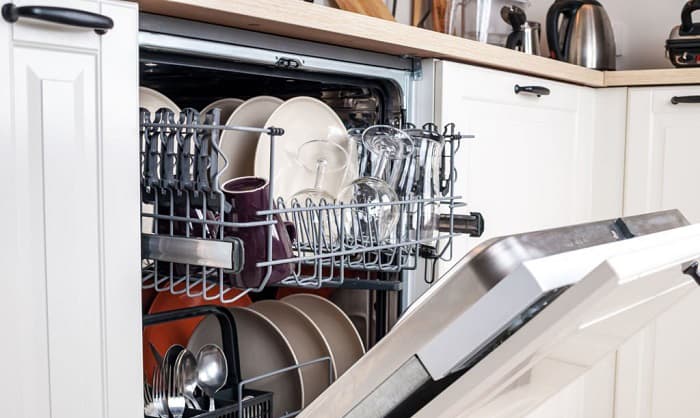
Are you at your wit’s end as to why dishwasher keeps tripping breaker? Well, it could be due to an outlet problem, a faulty component, water leakages, and damaged wires, connectors, and motor.
The variety of causes merits a more detailed explanation, so read on to know why they happen and what you should do about them. It’s worth knowing all of them to get to the bottom of things and could even help you save on replacement costs.
Table of Contents
1. Outlet Problem
2. damaged wires and loose connections, 3. faulty dishwasher parts, 4. leakages, 1. busted or loose wiring, 2. faulty control board, transorb, or other replaceable parts, 3. water leaking, reasons why the dishwasher keeps tripping the breaker.
Whether you have a Bosch dishwasher, a GE dishwasher, a Samsung dishwasher, or any other brand, expect to encounter similar breaker issues with plenty of them.
Even if it’s a new dishwasher, it’s still subject to a fault that may damage some essential parts, which, in turn, causes the appliance to malfunction. Once this happens, the breaker for the dishwasher will always trip unless you have it repaired or, in a few cases, replaced.
Here are the top reasons why your dishwasher may be tripping your property’s main circuit breaker.
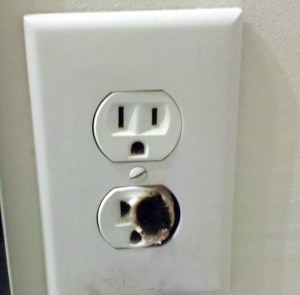
Let’s say your LG dishwasher suddenly trips the breaker after you plug it in, and when flipped, its switch back on, the outlet starts emitting smoke.
Don’t plug it in again once you encounter this issue – all the better if you already know that the breaker tripped the moment the dishwasher was plugged in. The dishwasher itself is not the problem but the outlet, which has most likely been compromised.
- How to Solve: This one needs to be seen and corrected by a licensed electrician immediately, especially if you have no knowledge and experience in fixing outlets.
Or learn how to replace an outlet. Usually, this involves cutting out the burnt wires and replacing wire nuts while tightening all the connections. You can start with this neat video that teaches the procedure step-by-step:
If the dishwasher’s motor was damaged, too, (which is likely since the outlet didn’t trip the breaker when you plugged it in again), you may need to have it repaired or replaced.
It could be due to this problem, especially if you know that your dishwasher is connected to a GFCI (ground fault circuit interrupter) , which is the one tripping and not your main breaker. If your breaker tripped during a cycle while it’s circulating water, it may be due to burnt wire caps or loose cord connections.
Typically, you’ll need to remove the toe panel and the junction box’s cover to see all the dishwasher’s wiring and connections. Be sure to shut down the breaker before making further investigations.
Look for telling signs like black, melted portions on the wire caps. Check for connections that have come loose or completely detached.
- How to Solve : Anything related to fixing a dishwasher issue that’s causing a circuit breaker to trip is expounded on in the second, main section of this article. Skip to that to learn how to fix problems related to damaged wires and components.
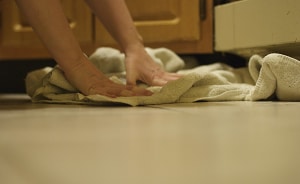
This same issue can trip a GFCI since it’s localized to the dishwasher. A fault or short tends to damage integral parts of the dishwasher, such as the heating element, causing the gadget to fail and the breaker to trip.
Shorted heating elements are one of the most common causes of dishwashers tripping the breaker. Even physical damage can be a factor, which, in turn, causes the heating element to begin functioning erratically, sometimes even drawing too much power that it needs.
The result? The breaker trips to keep you safe and prevent more damage from being done to the dishwasher. Take note that since it takes a while for the heating element to kick in during a cycle, it may take a few minutes or even up to 30 minutes before the dishwasher triggers a breaker trip.
That’s only one example, though. What are the other parts of the dishwasher that are worth checking out? Besides the motor, start with these common culprits:
- Control switches
- Control board
- Drain pumps
- Door latch system
Check for tell-tale clues like scorched portions, undesirable odors (especially on the transorb), and other obvious signs of damage on any of the parts mentioned above.
At best, these components could be tripping the breaker due to either one of these reasons, so it’s worth remembering all of them:
- The part becomes damaged or exposed to extreme temperature and moisture to the point of malfunctioning. Once that happens, the faulty part starts drawing in more power than what it needs, which the breaker detects.
As a result, it trips as a natural reaction. Usually, this happens when the heating element or motor fails.
- A fault or short circuit damages the component and then begins a domino effect that causes other parts to malfunction. A good example is when the transorb becomes defective to the point that it damages the control board.
I refer to both electrical leakages and leaking water problems when I say this. Damaged water pumps may cause the former. Any electrical leakage is bound to trip a properly functioning circuit breaker.
As for water leaking, it may be because the door switch was damaged, since it’s the one primarily responsible for preventing it. Remember that dishwashers can be destroyed by water, too.
Once you discover that it’s leaking and not filling up with water correctly, don’t delay checking the dishwasher for the exact component causing it. Oftentimes, leaks may not trip the breaker now, but over time, once the other vital parts become damaged, don’t be surprised once it starts to happen.
How to Fix a Dishwasher That Keeps Tripping the Breaker
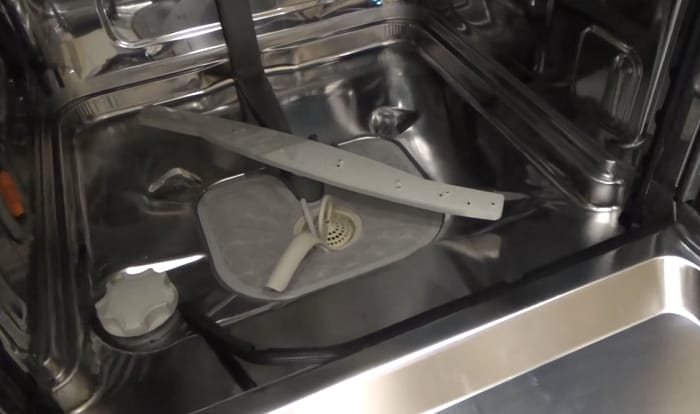
Much like any electrical problem, the fix mainly depends on the cause. There are issues where you can still salvage the dishwasher, while others leave you no choice but to replace it.
With that said, let’s cross out the dishwasher issues that normally can’t be fixed. You have no other choice but to replace the dishwasher if:
- Its motor becomes significantly damaged. This requires a technician’s expert eye to verify. Be mindful of the correct dishwasher voltage when you decide to buy a new one.
- It’s no longer functioning as well as before and there are signs of rusting.
With the irreparable issues out of the way, here are the problems and their appropriate fixes:
Let’s assume your KitchenAid or Whirlpool dishwasher has burnt out, damaged, melted, or torn-up wires once you’ve gained access to them. The easy fix to this is to cut out the compromised portions of the wires simply. Afterward, strip a new end to replace them.
Any wire that has gotten loose for some reason needs to be re-screwed to the correct terminal connections.
Once you pinpoint that the control board, drain pump, door latch system, or transorb is the one causing the dishwasher to fail and trip the circuit breaker, you’ll simply need to replace it. Check the manufacturer’s manual for the exact model and be sure to buy only that.
Before they start causing permanent damage, replace the wash pumps once you confirm that they’re leaking.
I hope you are able to pinpoint the exact reason why dishwasher keeps tripping breaker with the information I shared here. Overall, these reasons could be due to a number of interconnected issues like shorts and faults that damage essential wiring components, leading to trips or leakages.
If you’re unsure of your findings and what steps you should take next, don’t have second thoughts about calling your local electrician or the dishwasher’s manufacturer.
Read next: Choosing the Most Proper Breaker Amps for a Dishwasher.

I am Andrew Wright. With 8 years of experience designing, installing, and maintaining electrical power systems. I love my job, and I have always wanted to offer others the necessary help so they can take care of their houses.

Kenmore Dishwasher Keeps Tripping Breaker/Blowing Fuse
Posted on Last updated: November 12, 2023
Categories Dishwasher , Home and Kitchen
A Kenmore dishwasher works well to clean and dry your dishes when needed. However, you know something is wrong when your circuit breaker or fuse keeps breaking, rendering your dishwasher unusable. This article explores a number of reasons why this might be happening so that you will know how to fix your Kenmore Dishwasher.
A Kenmore dishwasher will trip your breaker when there is excessive current detected in the dishwasher’s circuits, usually caused by damaged wires or parts. The thermal fuse will blow in response to excess temperatures. This can also be due to excess current or a heating element that won’t turn off.

I will explain in more detail which components can cause your circuit breaker to trip and why the heating element will not turn off. You may appreciate the role of the thermal fuse more when you understand the consequences of your dishwasher overheating.
Kenmore Dishwasher Keeps Tripping Breaker
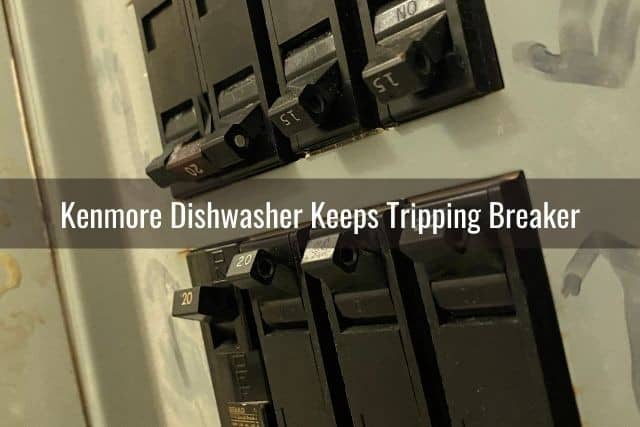
A circuit breaker is designed to prevent excessive amounts of electricity flowing through the wiring in your house. If the voltage and current is too high, the wires can heat to a dangerous level that has the potential to cause a fire.
Your dishwasher, and all other appliances in the home, are designed to place a certain amount of resistance on the electricity circuit to prevent overload. More resistance means less electricity can flow through the circuit.
If there is an electrical fault causing a short circuit, a low-resistance pathway is created for electricity to flow, which increases the voltage and current. This circuit then reaches dangerous levels, which triggers the circuit breaker to open the circuit. Once the circuit is open, you will lose power to all appliances connected to the same circuit.
Finding the issue is best done by a certified electrician as they will have all the necessary safety gear. If you decide to explore why your dishwasher is tripping the breaker yourself, it is extremely important to turn off the electricity beforehand. Failing to do so puts you at risk of receiving an electric shock.
There are many wires within the dishwasher, delivering power to all electronic controls. This includes the circuit board, solenoids, heating element, control panel, etc.
Therefore, the problem could be anywhere within the dishwasher’s wiring. However, there are common areas that can cause your breaker to trip, which I will explain below.
External Wiring
One of these areas is the power cable connection. If the power cable is the cause of the electrical trip, this should occur shortly after turning the dishwasher on.
Sometimes the exposed portion of wire can melt, welding together. This creates a connection between the earthing wire and the live wire, forming a short circuit.
This connection can also be created by contact with water, such as a leak from the dishwasher. If this is the case, you will need to find the source of the leak before trying to fix the short circuit issues. If you notice water around or under your dishwasher, below are the most common causes for a leak.
· Dishwasher is not level
· Compromised door seal
· Leaking drain pipe or water inlet valve
· Blocked filter
· Broken pump
DID YOU KNOW: A Kenmore dishwasher soap dispenser not working can often be due to soap buildup blocking the dispenser mechanism. Over time, detergent can form clumps that prevent the dispenser door from opening. Clean the dispenser thoroughly with hot water and a soft brush to remove buildup. Regular cleaning can prevent soap from clogging the mechanism and ensure it operates correctly.
Circuit Board
You may also have an issue with your circuit board. The wiring on a circuit board is so fine that it is very sensitive to overheating or moisture. This circuit board is located in the dishwasher door near the control panel.
If you have a compromised door seal, moisture may have entered the internal door compartment and short-circuited the circuit board. Excessive heat can also melt the wires, creating bad connections.
You should be able to see damage or moisture if you inspect the circuit board. If this is your problem, your dishwasher could trip the breaker at any time because it controls all functions.
Heating Element
The heating element can also become damaged and trip your circuit breaker. Sometimes this may be damage to the element itself or damage to the wire connections. Either way, you should notice the breaker trip when the element is turned on.
During a normal cycle, the dishwasher will empty water into the tub before turning the heating element on. This means that there will be a delay before the breaker is tripped and you should hear the water running into the dishwasher first. A damaged or faulty element will need to be replaced.
If the motor in the pump is malfunctioning, this can also cause a short circuit. Unfortunately, a pump/motor also needs to be replaced if faulty.
The motor functions when water is pumped around the dishwasher and also when the water is drained. If the motor trips the breaker when pumping water around the tub, this will also occur after the water has entered the dishwasher.
Kenmore Dishwasher Keeps Blowing Fuse

A fuse is made up of a delicate piece of wire connected to the main circuit of an appliance. This wire is designed to break when subjected to a maximum current (in an electrical fuse) or temperature (in a thermal fuse). Once the wire connection is broken, the circuit is open and the appliance can no longer function.
Kenmore dishwashers have a thermal fuse, located on the circuit board, which prevents the circuit from overheating. They are designed to be one-use-only, so need to be replaced once they are blown. When the fuse blows, the dishwasher will turn off immediately and will not turn back on until the fuse has been replaced or bypassed.
There are a number of reasons why a thermal fuse would keep blowing, which have been outlined below. All of these relate to the temperature rising in the dishwasher. A thermal fuse is useful in heated appliances because they can still overheat without having excess current running through the circuitry.
Too Much Electrical Current
Although thermal fuses are primarily designed to blow when subjected to high temperatures, these high temperatures can still be caused by excessive electrical currents running through the dishwasher circuit. More current produces more heat, which is why overloaded wires can become burnt on circuit boards.
Therefore, any of the wiring issues that can trip your circuit breaker can also blow the thermal fuse in your dishwasher. In the case of an electrical overload, you may notice burn marks on the control board. This will indicate that you need to investigate the electrical components mentioned above.
Copyright protected content owner: ReadyToDIY.com and was initially posted on July 19, 2021.
Heating Element Overheating
The heating element is designed to be turned on and off, depending on how hot the water is within the dishwasher. The element itself cannot detect when to turn off, but must receive a signal from the circuit board. The circuit board knows when to send this signal due to the thermostat that is measuring the water temperature.
Therefore, if there are any mixed signals coming from the circuit board to the heating element, the water may heat up to unsafe temperatures. This will cause the thermistor to blow.
It could also be due to a broken thermostat, which is not registering that the water is hot enough. In this case, the signal is not sent to the control board to turn off the heating element.
If your thermal fuse is breaking continuously from excessive water temperatures, you should start to notice the effects of these high temperatures. You will notice that your dishes are too hot to touch after the cycle has completed, or that some dishes are cracking under the intense heat. Plastics, in particular, will melt and be irreversibly damaged.
Interestingly, water that is too hot can affect the performance of the dishwasher. High temperatures can break down the enzymes in your detergent too quickly, meaning they do not clean the dishes as thoroughly. Hot water also increases the chances of limescale building up in the dishwasher.
Copyright article owner is ReadyToDiy.com for this article. This post was first published on July 19, 2021.
Therefore, the thermal fuse not only protects the dishwasher from internal damage or fire. It also enhances the performance of the dishwasher by ensuring that the water temperature does not exceed ideal levels when the heating element has not been switched off.
Related Articles
Kenmore Dishwasher Soap Dispenser Not Working
Kenmore Dishwasher Draining Problem
Kenmore Dishwasher Keeps Beeping
Kenmore Dishwasher Not Turning On or Off
ReadyToDIY is the owner of this article. This post was published on July 19, 2021.
Kenmore Dishwasher Light Blinking/Flashing

How to Fix a Breaker That Keeps Tripping
"Ok, where's the flashlight?"
We've all had to deal with tripped circuit breakers . They're annoying and happen at the worst times. As a licensed electrician, I've seen my fair share of breakers, tripped or otherwise.
Circuit breakers monitor the flow of electricity through a circuit. If it exceeds a preset amount, it opens the circuit to stop the current flow. They're a vital piece of your home's electrical system. And when they trip, they're trying to tell you something.
Occasional trips are not something to be alarmed about. But if a circuit breaker in your home keeps tripping, it could be a sign something's wrong.
How To Know if Your Circuit Breaker Is Tripping
If your breaker trips, go to your electrical panel and open the front cover. There should be two columns of circuit breakers and, hopefully, nice labels indicating what circuits each one controls. Most breakers will be on, so look for the one with the handle in a different position than the others.
On every breaker, there will be an "On" and "Off" position. On a tripped breaker, the handle will be in the middle, neither On nor Off. To reset, flip the handle to Off first, then to On. Stand to the side of the panel and turn your face away when flipping breakers. If an arc flash occurs, it may save your life.
Why Does My Circuit Breaker Keep Tripping?
Circuit breakers trip when too much electricity flows through the breaker. Circuit breakers are rated based on how much electricity can safely flow through the electrical circuit they're protecting. When that's exceeded, the breakers trip. A 20-amp breaker trips when more than 20 amps of current is on the circuit.
Circuit breakers trip for three main reasons:
- Short circuits;
- Ground faults.
What Is a Circuit Overload?
An overloaded circuit has too many things running on it at once.
Imagine a kitchen with a microwave and an air fryer next to each other. Kitchen small appliance circuits are 20 amps. A 1,200-watt microwave draws 10 amps. A 1,700-watt air fryer draws about 14 amps. Running both appliances at the same time puts 24 amps on a circuit designed for 20 amps.
Over time, those extra amps will damage the wires by generating excessive heat. A circuit breaker stops this overload condition by opening the circuit.
What Is a Short Circuit?
A short circuit happens when a hot wire comes in contact with another hot wire, or the neutral or ground. When a circuit operates normally, current flows on the hot wire from your electrical panel to a light, appliance or other load. Then it goes back to the panel via the neutral.
If the hot and neutral accidentally touch each other, the current takes a "shortcut" back to the panel instead of going to the load. The electricity generated by this contact is many times higher than if it was being used by a light or appliance. It's an extremely dangerous situation that can cause shocks and fires.
What Is a Ground Fault?
A ground fault is a type of short circuit. Ground faults happen when a hot wire touches a non-current carrying part of the electrical circuit, like a metal box or pipe. It's important for that unintentional, really high current to have a place to go, so non-current-carrying parts of your home's electrical system are bonded together and connected to a ground.
If there's no purposeful path to channel that ground fault current safely, it will go through anything available, including you. Ground-fault circuit interrupters (GFCI) are specifically designed to monitor for ground faults, but regular circuit breakers also provide protection.
How To Fix a Circuit Breaker That Keeps Tripping
If your breaker keeps tripping, investigate and fix the problem. Here are a few ways to narrow down the possibilities. Always call a licensed electrician if the issue becomes too involved.
Check for overload
Figure out which area of the house the tripped breaker controls, then turn off and unplug everything in that area. Lights, microwaves, computers, everything. Then go turn on the breaker. If the breaker trips immediately, even with nothing plugged in, it's likely you have a short, not an overload.
If the breaker holds, go back to the room and start plugging things in and turning them on one by one. After each item, pause, then do the next one. When the breaker trips again, you know you've reached your limit for that circuit. Redistribute the loads more evenly between circuits if possible.
Check for a short in a specific appliance
Shorts and ground faults can occur within an appliance or other electrical device when a hot wire touches the housing.
Note the last thing you plugged in when the breaker tripped while checking for an overload. If you plug that appliance or device into another circuit, does that circuit trip as well? If so, unplug the device immediately and don't use it until it's replaced or serviced.
Call an electrician for shorts and ground faults in the wiring
If the breaker trips immediately upon resetting, even with nothing plugged in or turned on, it's likely something in your home's wiring causing the problem. This could be a loose connection at a receptacle or other device, or something more complicated, like worn insulation within your walls.
If you have electrical experience and can determine which device is causing the short, replace the device or correct the loose wire. If you're not experienced, or you smell something burning or see scorch marks on your walls, call a professional licensed electrician. Do the same if you have repeated problems with flickering lights or tripping breakers.
Electrical fires and shocks are dangerous, and shorts and ground faults are difficult to find. A pro can diagnose and fix the issue, providing peace of mind.
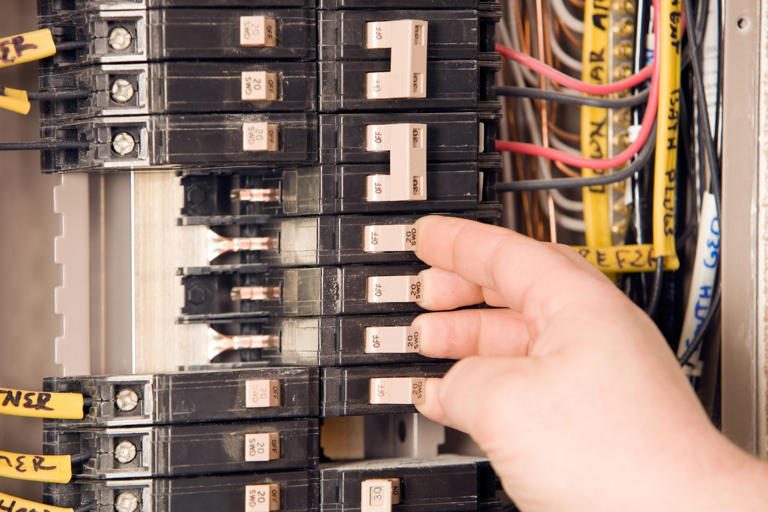
Why Does My Dishwasher Keep Tripping the Electrics: Common Causes and Solutions
Have you ever experienced the frustration of your dishwasher constantly tripping the electrics? It can be an annoying and inconvenient problem to deal with. However, understanding the common causes behind this issue can help you find the right solutions. In this article, we will discuss why your dishwasher keeps tripping the electrics and provide some practical tips to resolve this problem.
Table of Contents
Common Causes of Dishwasher Tripping the Electrics
1. overloaded circuit.
One of the common causes of a dishwasher tripping the electrics is an overloaded circuit. Dishwashers require a significant amount of power to operate, and if the circuit you have connected your dishwasher to is already handling a heavy load, it may become overwhelmed. This overload can result in the circuit breaker tripping, causing your dishwasher to lose power.
2. Faulty Wiring
Another potential cause could be faulty wiring. Over time, the electrical connections inside your dishwasher or within the electrical system of your home can deteriorate. This can lead to loose connections or exposed wires, which can cause a short circuit and trip the circuit breaker. Faulty wiring should be repaired by a qualified electrician to prevent any safety hazards.
3. Appliance Malfunction
Sometimes, the problem may not be related to the electrical system itself, but rather a malfunction within the dishwasher. Issues such as a faulty motor, pump, or heating element can cause a sudden surge in electricity consumption, leading to the tripping of the electrics. In such cases, it’s essential to address the specific malfunction to resolve the problem.
4. Water Leakage
Water leakage within the dishwasher can also be a culprit behind the constant tripping of the electrics. If water enters the electrical components of the appliance, it can cause a short circuit and result in the circuit breaker tripping. Regularly inspecting your dishwasher for any signs of leakage and promptly addressing them can help prevent electrical problems.
Solutions for Dishwasher Tripping the Electrics
1. check the circuit load.
If your dishwasher is tripping the electrics, start by checking the circuit load. Determine what other appliances or devices are connected to the same circuit and assess their power consumption. If the circuit is already handling a heavy load, consider spreading the electrical demand by redistributing appliances to different circuits. This can help prevent an overload and keep your dishwasher running smoothly.
2. Inspect the Wiring
In case you suspect faulty wiring as the root cause, it’s crucial to have a professional electrician inspect and repair the damaged wiring. They can identify any loose connections, replace faulty wires, and ensure proper grounding. It’s always recommended to seek professional assistance when dealing with electrical issues to guarantee your safety and avoid any further damage to the dishwasher or your home’s electrical system.
3. Perform Regular Maintenance
Regular maintenance of your dishwasher can help prevent potential issues that may lead to tripping the electrics. Inspect the appliance for any signs of water leakage, loose electrical connections, or worn-out components. Clean the dishwasher filters, remove any debris, and follow the manufacturer’s instructions for general maintenance. By keeping your dishwasher in good condition, you can reduce the chances of electrical problems occurring.
4. Upgrade to a Dedicated Circuit
If you frequently experience your dishwasher tripping the electrics even after redistributing the load, consider upgrading to a dedicated circuit solely for your dishwasher. This ensures that the dishwasher operates on its own independent circuit, reducing the risk of overloading and tripping the circuit breaker. Consult with a qualified electrician to assess your home’s electrical system and determine the feasibility of this solution.
5. Consult the Manufacturer or a Professional
If you have tried the above solutions and are still facing issues with your dishwasher tripping the electrics, it’s advisable to consult the dishwasher manufacturer or a professional electrician. They can provide specific guidance based on the model and make of your dishwasher, diagnose any technical faults, and offer appropriate solutions.
In conclusion, a dishwasher constantly tripping the electrics can be caused by various factors such as an overloaded circuit, faulty wiring, appliance malfunction, or water leakage. By understanding these common causes and implementing the suggested solutions, you can alleviate this issue and enjoy the convenience of a properly functioning dishwasher. Remember to prioritize your safety and seek professional assistance whenever necessary.
Leave a Comment Cancel reply
Save my name, email, and website in this browser for the next time I comment.

Bosch Dishwasher Tripping Power: Causes and Solutions!
As an Amazon Associate, I earn from qualifying purchases. I get commissions for purchases made through links on this website from Amazon and other third parties.
To fix Bosch dishwasher tripping power, ensure the power cord is securely plugged in. Check for any visible damage on the cord. Inspect the circuit breaker for a tripped switch and reset if necessary. Test the outlet with another device. If issues persist, consult a professional technician to examine the dishwasher’s internal components for potential faults.
If you own a Bosch dishwasher and it keeps tripping rcd, you’re not alone. This issue is a common complaint among Bosch dishwasher owners. When your dishwasher trips the power, it can be frustrating, especially if it happens frequently. Fortunately, there are several potential causes of this problem, and most of them can be resolved without professional help.
Table of contents
Common Causes of Power Tripping

Here are some of the most common reasons why your dishwasher may be tripping your circuit breaker:
Faulty Wiring or Electrical Connections
One possible cause of power tripping is faulty wiring or electrical connections. Over time, the wiring and connections that supply power to your dishwasher can become damaged or loose, leading to short circuits and power tripping. If you suspect that this is the issue, it is best to call a qualified electrician to inspect and repair the wiring and connections.
Overloaded Electrical Circuits
Another common cause of Bosch dishwasher tripping rcd is overloaded electrical circuits. If you have multiple appliances or devices sharing the same electrical circuit, it can exceed its maximum capacity and cause the circuit breaker to trip. To prevent this issue, try to avoid using other high-powered appliances at the same time as your dishwasher, or consider installing a dedicated circuit for your dishwasher.
Defective Dishwasher Components
Defective dishwasher components can also cause power tripping. For example, a faulty heating element, control circuit board, or wash motor can cause an electrical short circuit that leads to power tripping. If you suspect that this is the issue, it is best to call a qualified technician to inspect and repair the defective component.
How To Fix Bosch Dishwasher Tripping Power Issue
If your Bosch dishwasher keeps tripping the power, there are a few fixing steps you can take to identify the issue.
Inspecting Electrical Outlets and Circuit Breakers
The first step in troubleshooting your Bosch dishwasher is to check the electrical outlets and circuit breakers. Start by unplugging the dishwasher and testing the outlet with a small lamp or other device to ensure it is functioning properly. If the outlet is not working, try resetting the circuit breaker or replacing the fuse.
If the outlet is working correctly, check the circuit breaker. If it has tripped, reset it by flipping the switch. If the circuit breaker trips again immediately after resetting, there may be an issue with the wiring or electrical system in your home. In this case, it’s best to call a qualified electrician to inspect and repair the problem.
Testing Dishwasher Components
If the electrical outlets and circuit breakers are functioning correctly, the next step is to examine the dishwasher components. Start by checking the dishwasher’s power cord and ensuring it is plugged in securely. If the power cord is loose, plug it in tightly and test the dishwasher again.
Next, inspect the dishwasher’s control panel for any visible damage or loose connections. If you notice any issues with the control panel, it may need to be replaced. Also, check the dishwasher’s heating element and wash motor for any signs of damage or wear.
In some cases, the dishwasher may be tripping the power due to an overloaded circuit. If you have multiple appliances or devices sharing the same electrical circuit, it can exceed its maximum capacity and cause the circuit breaker to trip. Try running the dishwasher on a different circuit to see if this resolves the issue.
Preventive Measures
Preventing your machine from tripping the power is essential to keep it running smoothly. Here are some preventive measures you can take to avoid this issue.
Regular Maintenance
Performing regular maintenance is crucial to keep your dishwasher in good condition. Make sure to clean the filters, spray arms, and interior of the dishwasher regularly. This will prevent any clogs, which can cause the dishwasher to work harder and trip the power. You can also use dishwasher cleaner to remove any buildup and keep the dishwasher running smoothly.
Proper Installation and Usage
Proper installation and usage of the dishwasher can also prevent it from tripping the power. When installing the dishwasher, make sure that it is properly grounded and that the electrical connections are secure.
Also, make sure not to overload the dishwasher by putting too many dishes in it. This can cause the dishwasher to work harder and trip the power. Plus, avoid using extension cords or adapters to connect the dishwasher to the power source. This can cause the dishwasher to draw too much power and trip the breaker.
Repair or Replace
If your dishwasher is tripping the power, you may be wondering whether to repair or replace it. Here are some factors to consider when making your decision.
DIY Repair Tips
If you’re handy, you may be able to fix the problem yourself. Some common DIY repair tips include checking the power supply, cleaning the filters, and inspecting the wiring. You can find helpful tips and tutorials online, such as on How To Fix It Guides . However, be aware that attempting a repair yourself can be dangerous and may void your warranty.
Professional Repair Services
If you’re not comfortable attempting a repair yourself, you can hire a professional repair service. They can diagnose the problem and fix it for you. You can find a qualified repair service through the Bosch website .
Assessing Replacement Options
If your dishwasher is old or the repair cost is high, it may be more cost-effective to replace it rather than repair it. Consider the age of your dishwasher, the cost of the repair, and the cost of a new dishwasher. You can find a wide range of Bosch dishwashers with different features and price points on Bosch’s website.
Decision to repair or replace your dishwasher depends on your situation. Consider your budget, the age of your dishwasher, and the cost of the repair. If you’re not comfortable attempting a repair yourself, hiring a professional repair service may be the best option. And if your dishwasher is old or the repair cost is high, it may be more cost-effective to replace it.
Safety Precautions That You Should Take Before Fixing Tripping Power Issue

Here are some safety measures you should take:
Turn Off the Power
Before attempting any repairs or fixing on your dishwasher, you should turn off the power to the unit. This will ensure that you do not receive an electric shock while working on the machine. To turn off the power, locate the circuit breaker that controls the dishwasher and flip the switch to the off position.
Wear Protective Gear
When working on your dishwasher, it is important to wear protective gear such as rubber gloves and safety glasses. This will protect your hands and eyes from any potential hazards such as sharp edges or hot surfaces.
Follow the User Manual
To avoid any potential hazards, it is important to follow the user manual provided by Bosch. The manual provides detailed instructions on operating and maintaining your dishwasher safely. It also includes troubleshooting tips and safety precautions that you should take while working on the machine.
Seek Professional Help
If you are unsure about how to fix or repair your Bosch dishwasher, it is best to seek professional help. Attempting to repair the machine without the necessary knowledge and expertise can be dangerous and can cause further damage to the unit. Contact a certified technician to diagnose and repair any issues with your dishwasher.
What could cause a dishwasher to immediately trip a circuit breaker?
If your Bosch dishwasher is tripping the circuit breaker as soon as you turn it on, it could be due to a faulty motor or a short circuit. A dishwasher’s motor draws a lot of power, and if it is damaged or malfunctioning, it could cause the circuit breaker to trip. Similarly, a short circuit could cause a sudden surge of current, which could also trip the breaker. In either case, it is recommended that you contact a qualified electrician or a Bosch technician to diagnose and repair the issue.
How can I troubleshoot a dishwasher that keeps tripping the RCD?
If your Bosch dishwasher keeps tripping the RCD (Residual Current Device), it could be due to a ground fault or a problem with the wiring. First, check to see if the dishwasher is plugged into a ground-fault circuit interrupter or GFCI. If it is, try resetting the GFCI. If this does not solve the problem, unplug the dishwasher and check the wiring for any signs of damage or wear. If you are unsure how to proceed, contact a qualified electrician or a Bosch technician for assistance.
What steps should I take if my dishwasher is tripping the safety switch?
If your Bosch machine is tripping the safety switch, it could be due to a fault in the dishwasher’s heating element or a short circuit in the wiring. First, unplug the dishwasher and check the heating element for any signs of damage or wear. If the element looks fine, check the wiring for any signs of damage or wear. If you are unsure how to proceed, contact a qualified electrician or a Bosch technician for assistance.
Are there common issues with dishwashers that could lead to power outages?
Yes, there are several common issues with dishwashers that could lead to power outages. These include overloaded circuits, faulty motors, damaged heating elements, and short circuits. Power outages can also be caused by issues with the electrical supply to your home. If you are experiencing power outages with your Bosch dishwasher, it is recommended that you contact a qualified electrician or a Bosch technician to diagnose and repair the issue.
Where can I locate the fuse in my Bosch dishwasher for inspection or replacement?
The location of the fuse in your Bosch dishwasher can vary depending on the model. However, in most cases, the fuse will be located on the control board or inside the door panel. Consult your dishwasher’s user manual or contact Bosch customer service for specific instructions on how to locate and inspect or replace the fuse. It is recommended that you do not attempt to replace the fuse yourself unless you are experienced in electrical repairs.
About the author
Jamil is your go-to expert for all things cleaning appliance related. With years of experience under his belt, has become quite the pro at fixing and maintaining various appliances like vacuum cleaners, washing machines, and dishwashers.
Latest posts
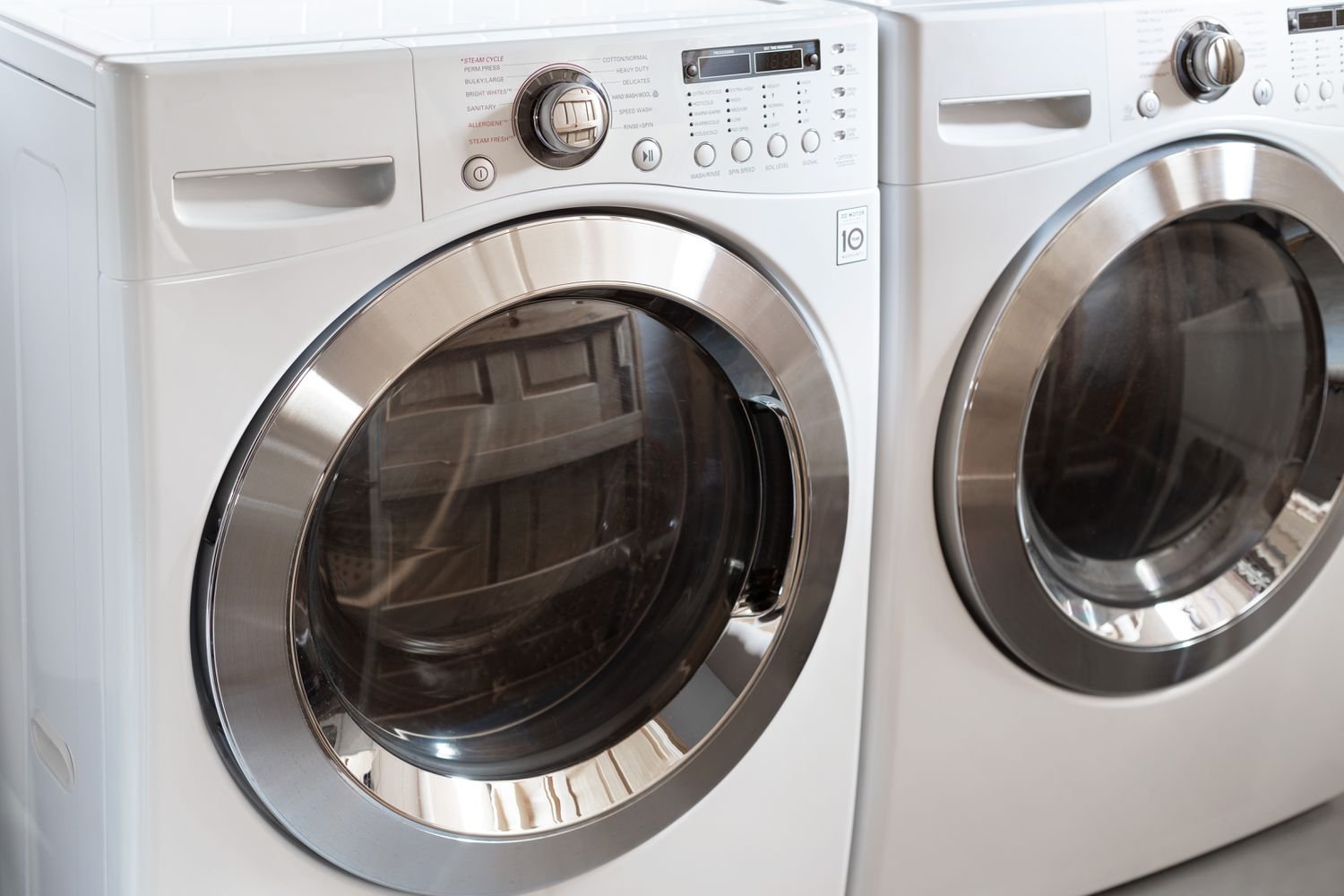
How Do You Know If Washing Machine is HE (High Efficiency)?
To determine if a washing machine is HE, check for the “HE” label on the appliance. High-efficiency (HE) washing machines are designed to use less water and energy than traditional […]

How Do You Know If Washing Machine Pump is Broken?
To know if the washing machine pump is broken, check for leaks underneath the machine and listen for unusual noises during operation. A malfunctioning pump can cause water not to […]
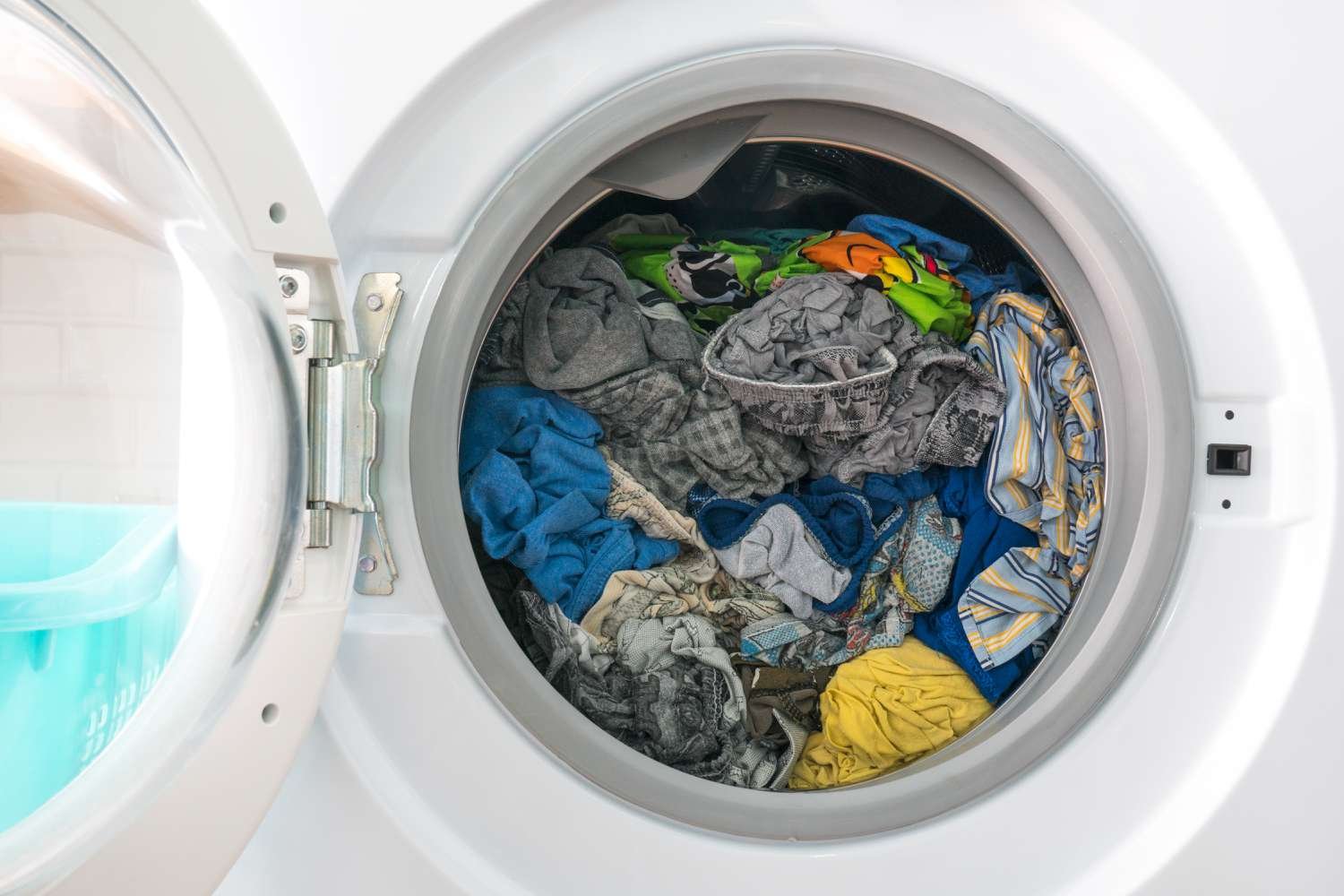
How Do You Know If Washing Machine Is Overloaded?
Your washing machine is overloaded if it struggles to start the cycle or the laundry is tightly packed with no room to move. An overloaded machine may make unusual noises […]

COMMENTS
Just load them up with dishes, turn them on, and let them work. Still, it can be very confusing and frustrating when a dishwasher keeps tripping your circuit breaker. A dishwasher may be tripping your breaker because of a problem with the heating element, loose or short-circuiting electrical connectors, a shorted transorb, a problematic control ...
A faulty motor can also explain why your dishwasher keeps tripping the breaker. You see, all dishwashers have a motor that helps to move the water up and around. However, if the motor is damaged, it can draw more power than normal, which can then cause the circuit board to trip. In my experience, when this happens, it's best to replace the ...
A dishwasher is a vital part of most households, simplifying the task of dishwashing and saving precious time. However, like any other appliance, dishwashers can develop issues over time. One common problem is the dishwasher tripping the circuit breaker.
If your dishwasher continues to trip the breaker, it could be due to any of the following causes: Electrical overload. Wiring issues. Faulty dishwasher components. Water-related issues. Ground Fault Circuit Interrupter (GFCI) problems.
Welcome to Electricity Frenzy! In this episode, we dive deep into a common household issue: a dishwasher tripping the circuit breaker. If you've ever experie...
Once the circuit has been safely turned off, you can disconnect the other appliances one by one and test the dishwasher to see if it continues to trip the circuit breaker. This step-by-step approach helps in isolating the dishwasher and identifying whether it is the main culprit behind the tripping issue.
Another possible cause of a dishwasher tripping the circuit breaker is a faulty dishwasher component. This can be anything from a damaged heating element to a malfunctioning motor. When a dishwasher component fails, it can cause an electrical short that trips the circuit breaker. To determine if a faulty dishwasher component is the cause of the ...
2. Faulty Heating Element. Another reason why your dishwasher might be tripping the circuit breaker is due to a faulty heating element. The heating element is responsible for heating up the water in the dishwasher. However, if it is not functioning correctly, it can cause the dishwasher to draw more power than it can handle, causing the circuit ...
Overloading. One of the most common reasons why a dishwasher might trip the breaker is because it's overloaded. Dishwashers are designed to handle a certain amount of dishes at a time, and if you exceed that limit, it can cause the machine to draw too much power and trip the breaker. This issue is more common in older dishwashers, which may ...
For a full written guide on why your dishwasher keeps tripping a circuit breaker, make sure to check out:https://applianceanalysts.com/dishwasher-tripping-ci...
Why does a dishwasher trip the circuit breaker? The culprit is often an electrical overload. Circuit breakers are designed to protect your home's electrical system. When there's too much demand on a circuit, the breaker "trips" or shuts off, effectively preventing any Grim Reaper-style fire outbreaks. 1. Dishwasher Gone Rogue
Having a dishwasher that keeps tripping the breaker can be cause for concern. It always has some underlying electrical issues. Identifying the cause behind it is the first step in resolving any tripping issue. Here are some common issues that make the dishwasher trip the circuit breaker: Shared Circuit and Power Overload. This is a no-brainer.
Step One: Check For A Tripping Breaker. If you are connecting your dishwasher to an outlet and it is tripping the breaker it could be that the dishwasher is too heavy for the circuit. The breaker is designed to protect the appliance from getting overloaded by disconnecting the dishwasher from the electrical current.
If your dishwasher keeps tripping the circuit breaker, first try unplugging other appliances on the same circuit to see if the problem persists. If the dishwasher still trips the breaker, it could indicate an issue with the appliance itself. Check for any loose connections, frayed wires, or water leaks that may be causing a short circuit. ...
It's worth knowing all of them to get to the bottom of things and could even help you save on replacement costs. Table of Contents. Reasons Why the Dishwasher Keeps Tripping the Breaker. 1. Outlet Problem. 2. Damaged Wires and Loose Connections. 3. Faulty Dishwasher Parts.
Bosch dishwasher tripping circuit breaker . Check the electricity setup. First, please check that your electricity setup is able to support the use of several machines running at the same time.
A dishwasher generally requires a significant amount of power to function efficiently. It usually runs on a 120-volt electrical circuit, which connects to a dedicated circuit breaker in your electrical panel. This breaker is designed to trip whenever there is an overload or a short circuit to protect your home from electrical hazards.
Devices charging slowly. Electrical outlets not working. Flickering lights. Scorch marks on outlets and light switches. If a circuit breaker keeps tripping in one room, homeowners can test for ...
Kenmore Dishwasher Keeps Blowing Fuse. A fuse is made up of a delicate piece of wire connected to the main circuit of an appliance. This wire is designed to break when subjected to a maximum current (in an electrical fuse) or temperature (in a thermal fuse). Once the wire connection is broken, the circuit is open and the appliance can no longer ...
Figure out which area of the house the tripped breaker controls, then turn off and unplug everything in that area. Lights, microwaves, computers, everything. Then go turn on the breaker. If the ...
Faulty Heating Element. Even if your dishwasher uses a hot water connection, your dishwasher also uses a heating element to heat the water to the appropriate temperature. However, if your heating element has become damaged or is malfunctioning and using too much electricity, it can cause the circuit breaker to trip unexpectedly and often. Sharing.
4. Water Leakage. Water leakage within the dishwasher can also be a culprit behind the constant tripping of the electrics. If water enters the electrical components of the appliance, it can cause a short circuit and result in the circuit breaker tripping. Regularly inspecting your dishwasher for any signs of leakage and promptly addressing them ...
If your Bosch dishwasher is tripping the circuit breaker as soon as you turn it on, it could be due to a faulty motor or a short circuit. A dishwasher's motor draws a lot of power, and if it is damaged or malfunctioning, it could cause the circuit breaker to trip. Similarly, a short circuit could cause a sudden surge of current, which could ...
If it completes a cycle, you know the problem is in the heater. If the breaker trips at the very end of the cycle, I suspect that the timer breaking the circuit to the element is causing the issue, and I'd swap the timer. I wouldn't just toss a different heater in it because you run the risk of creating a leak, and I wouldn't risk the ...